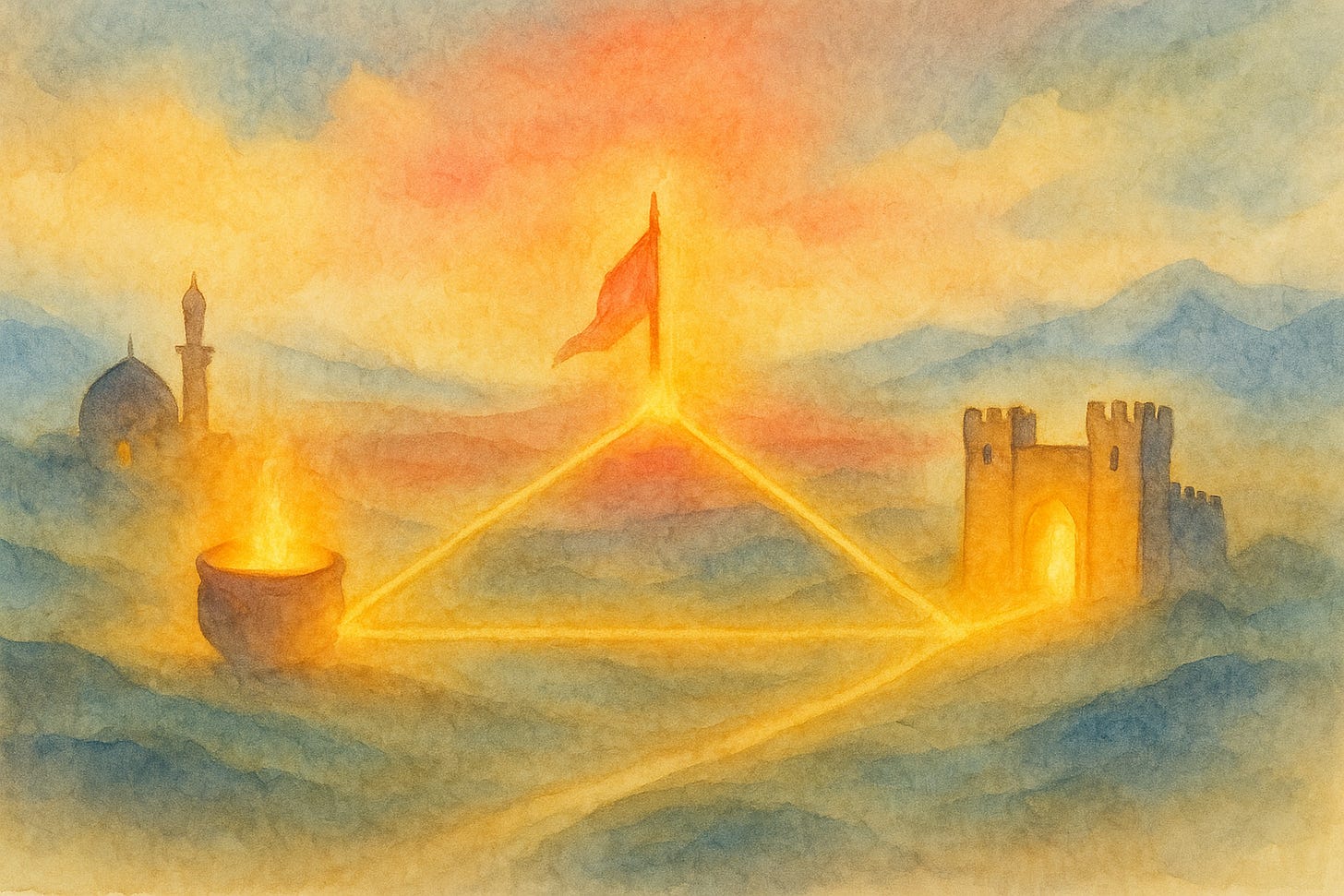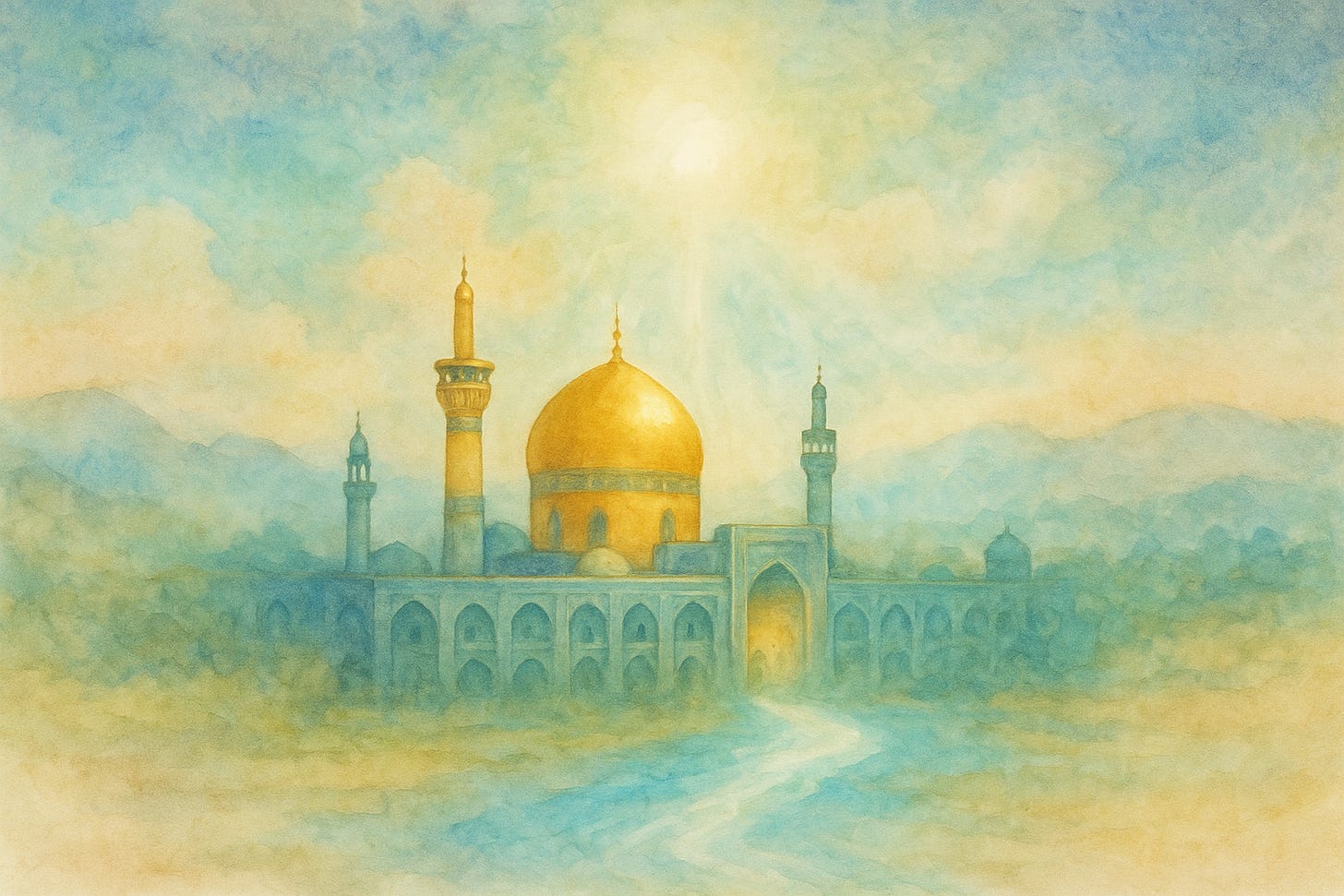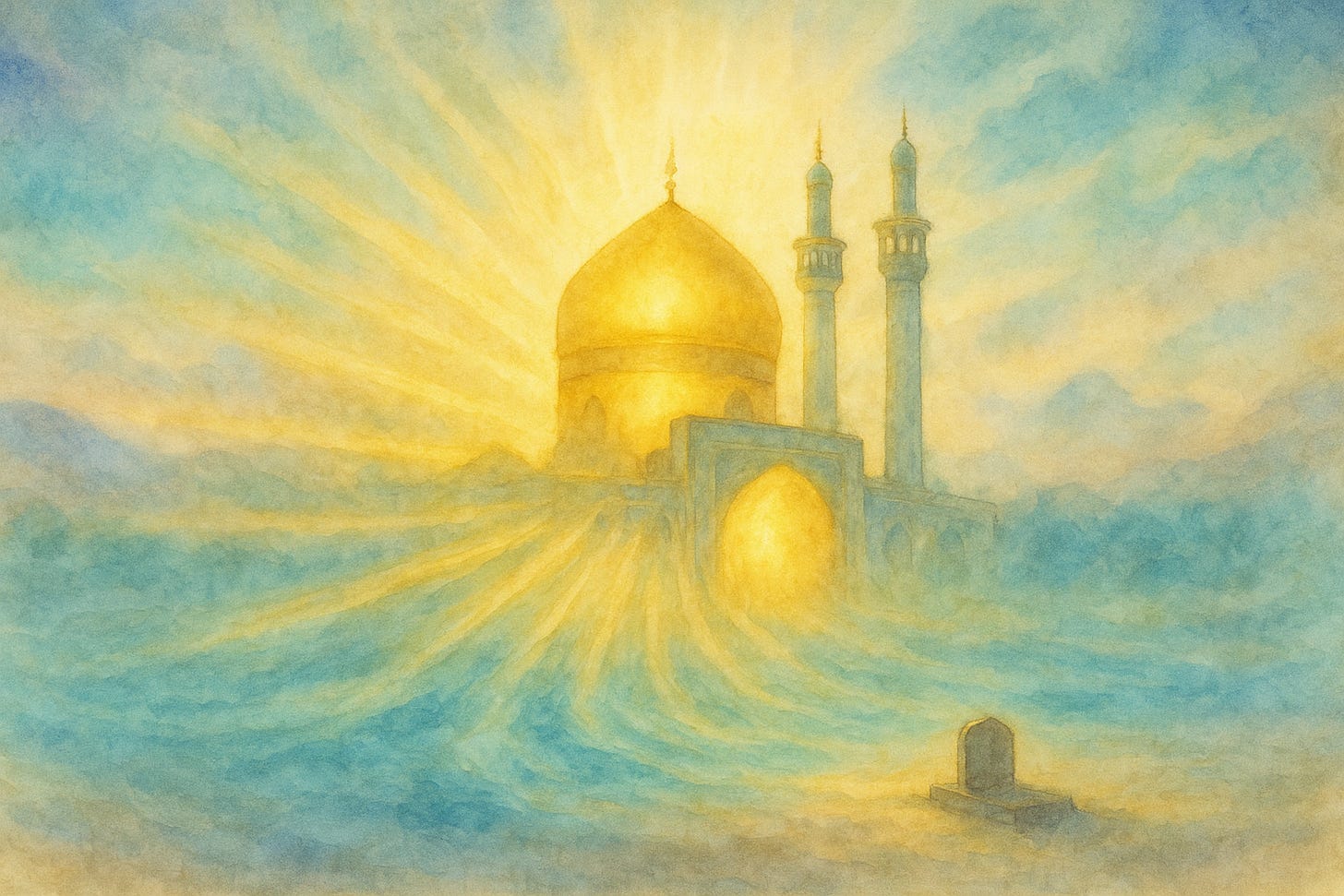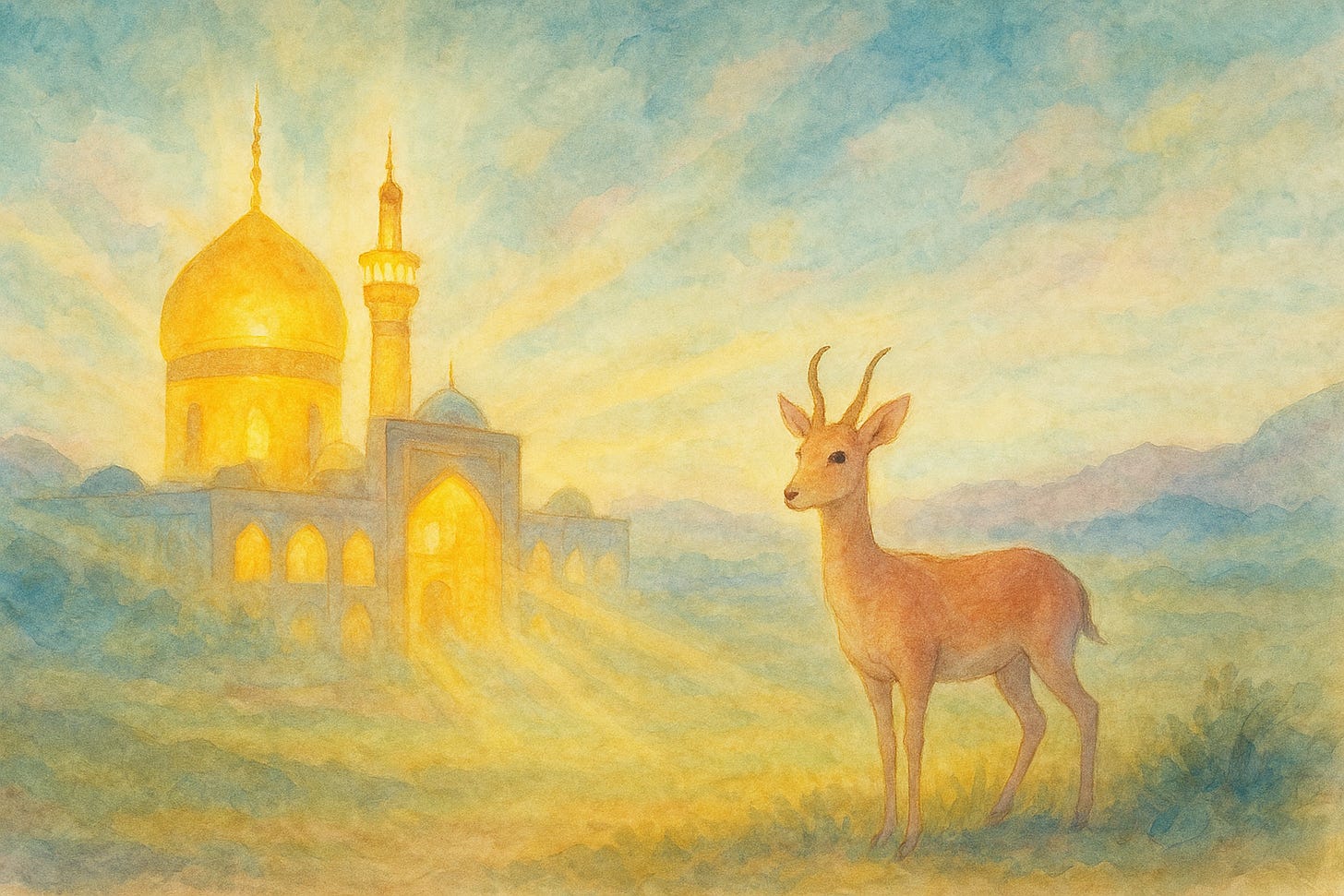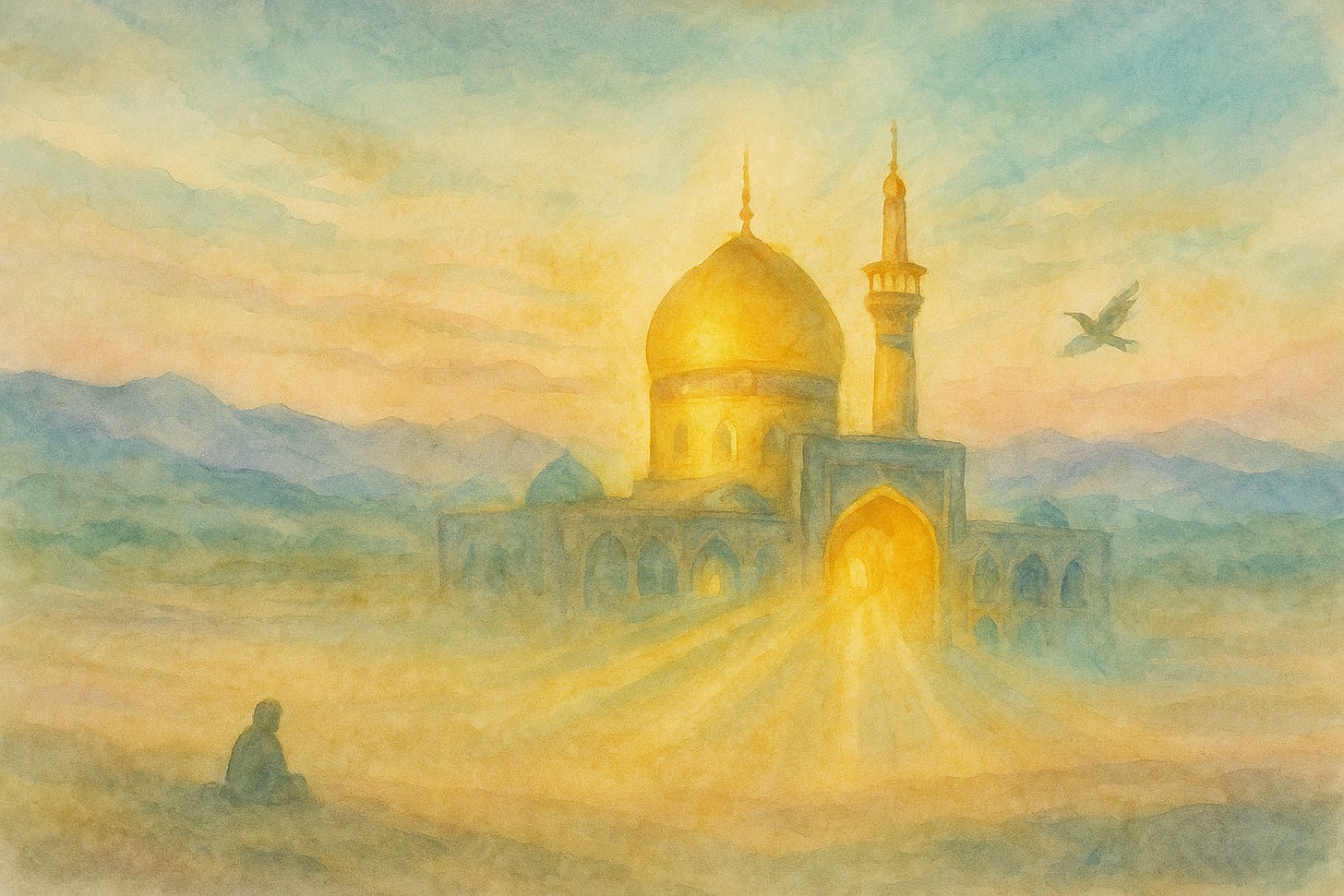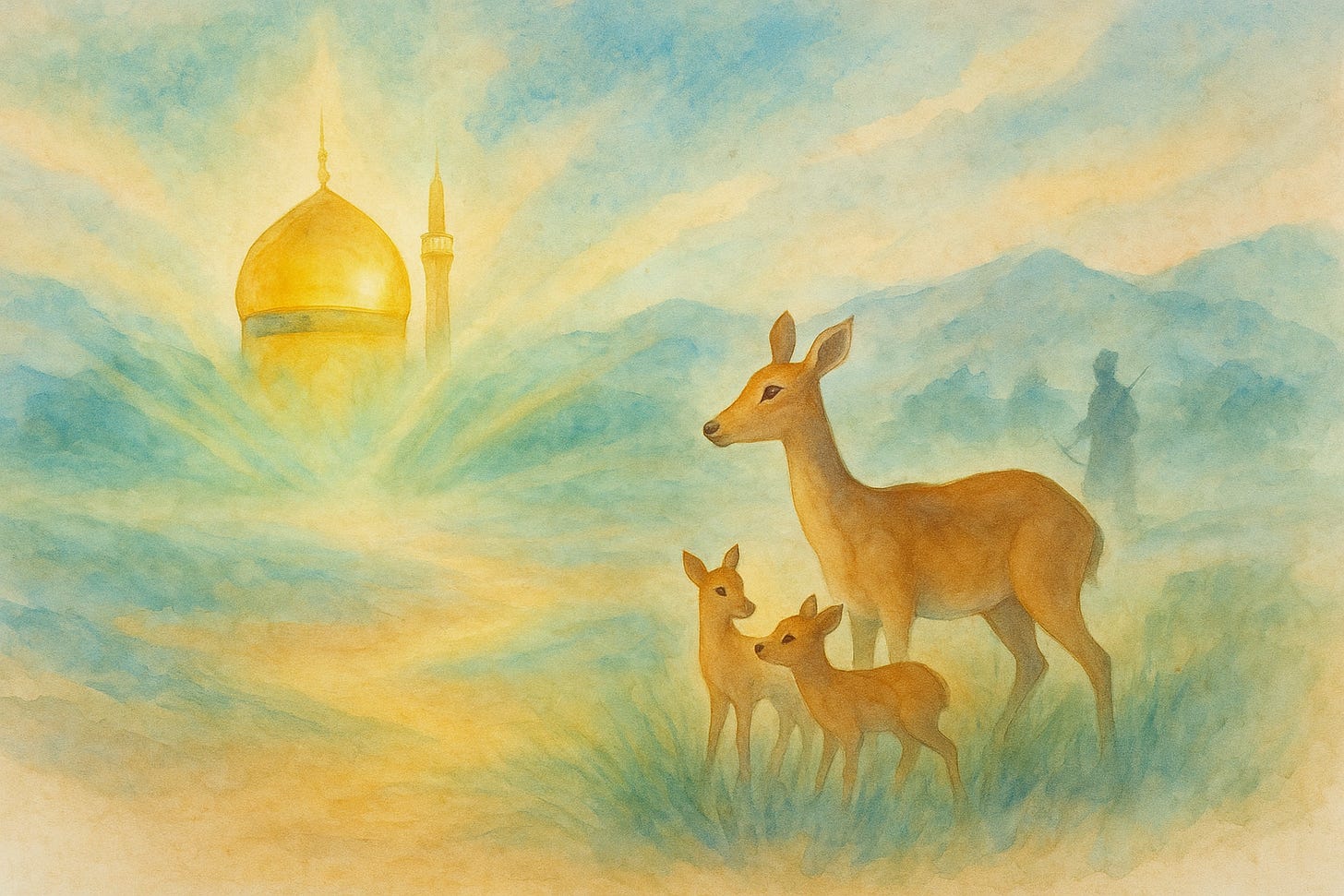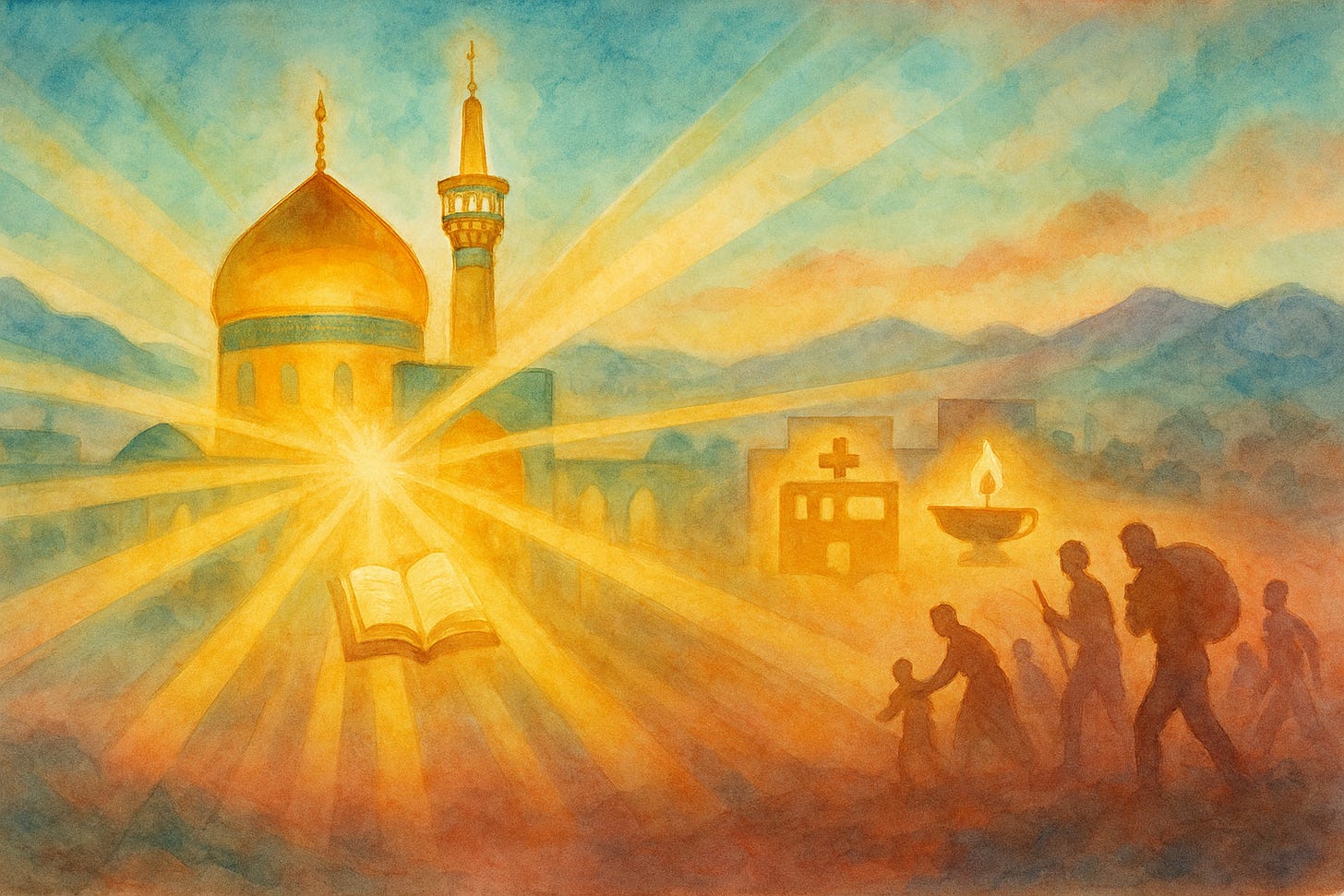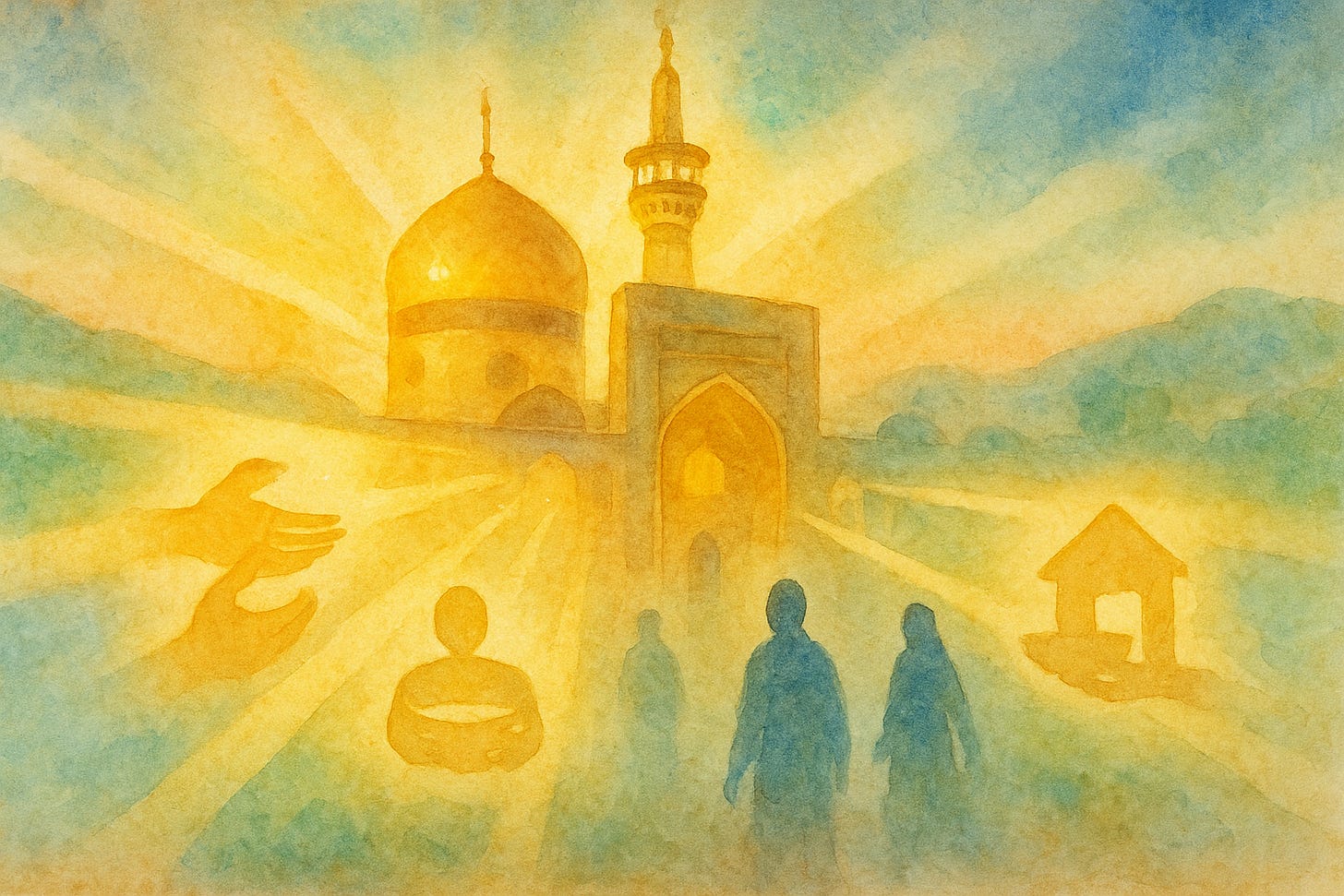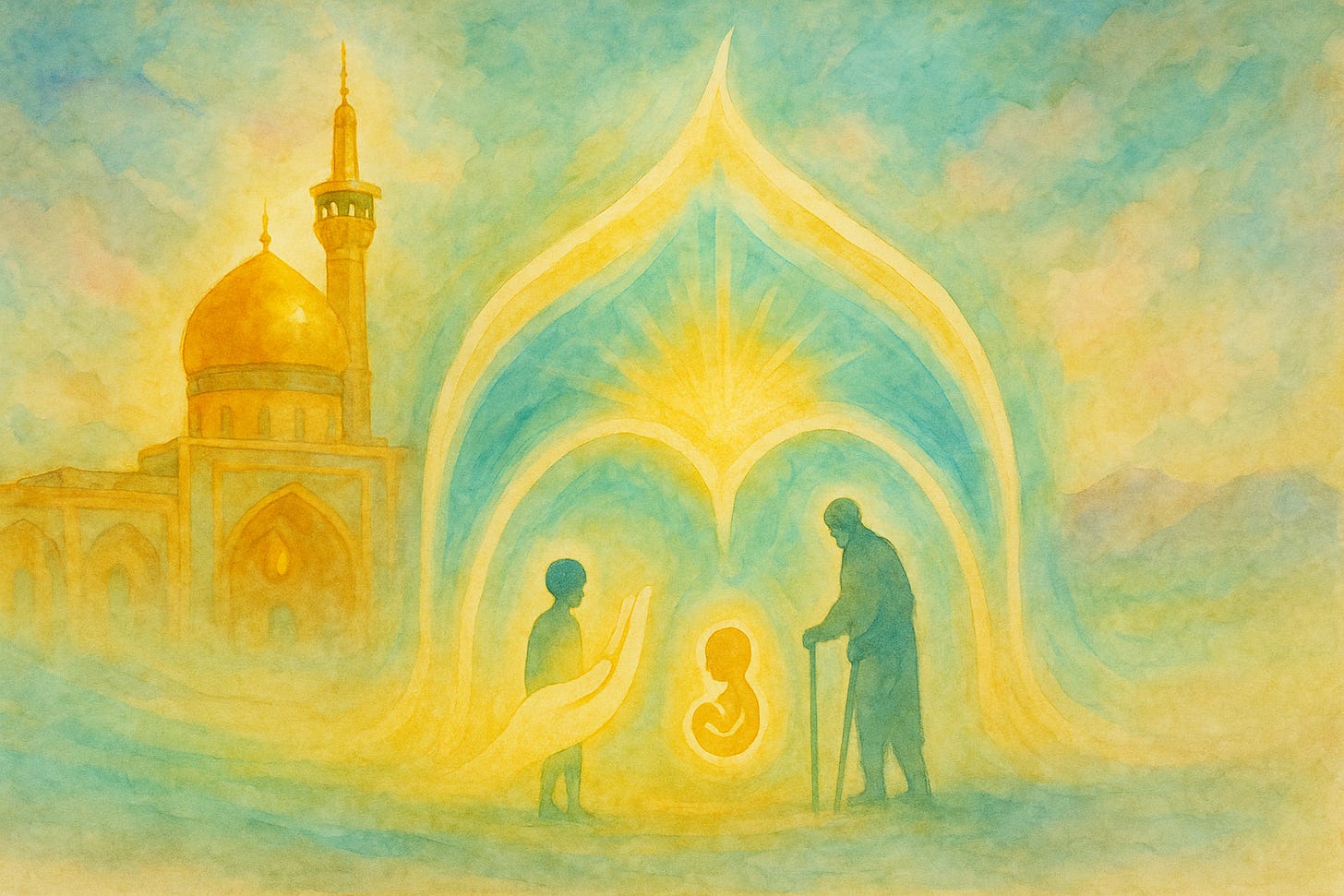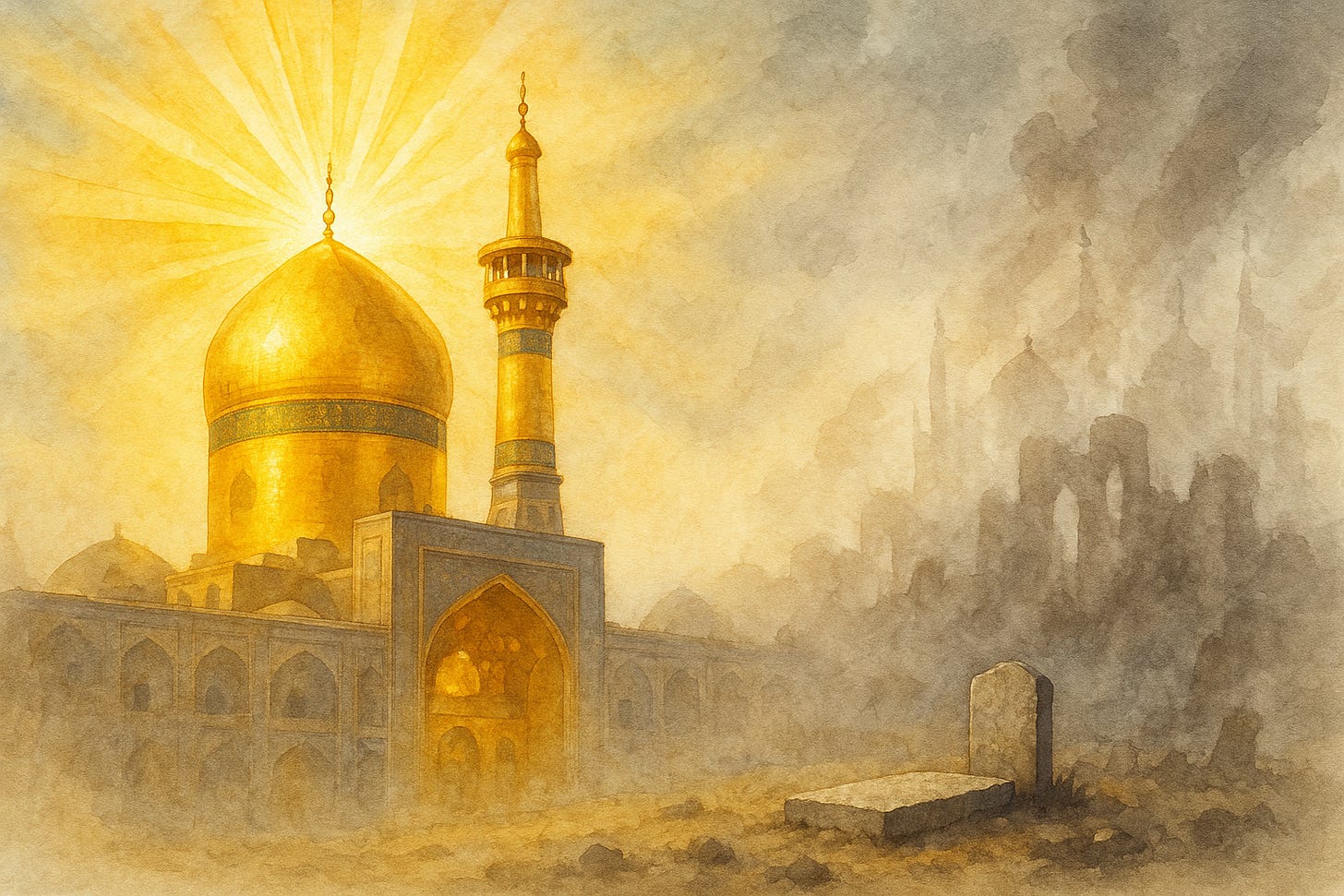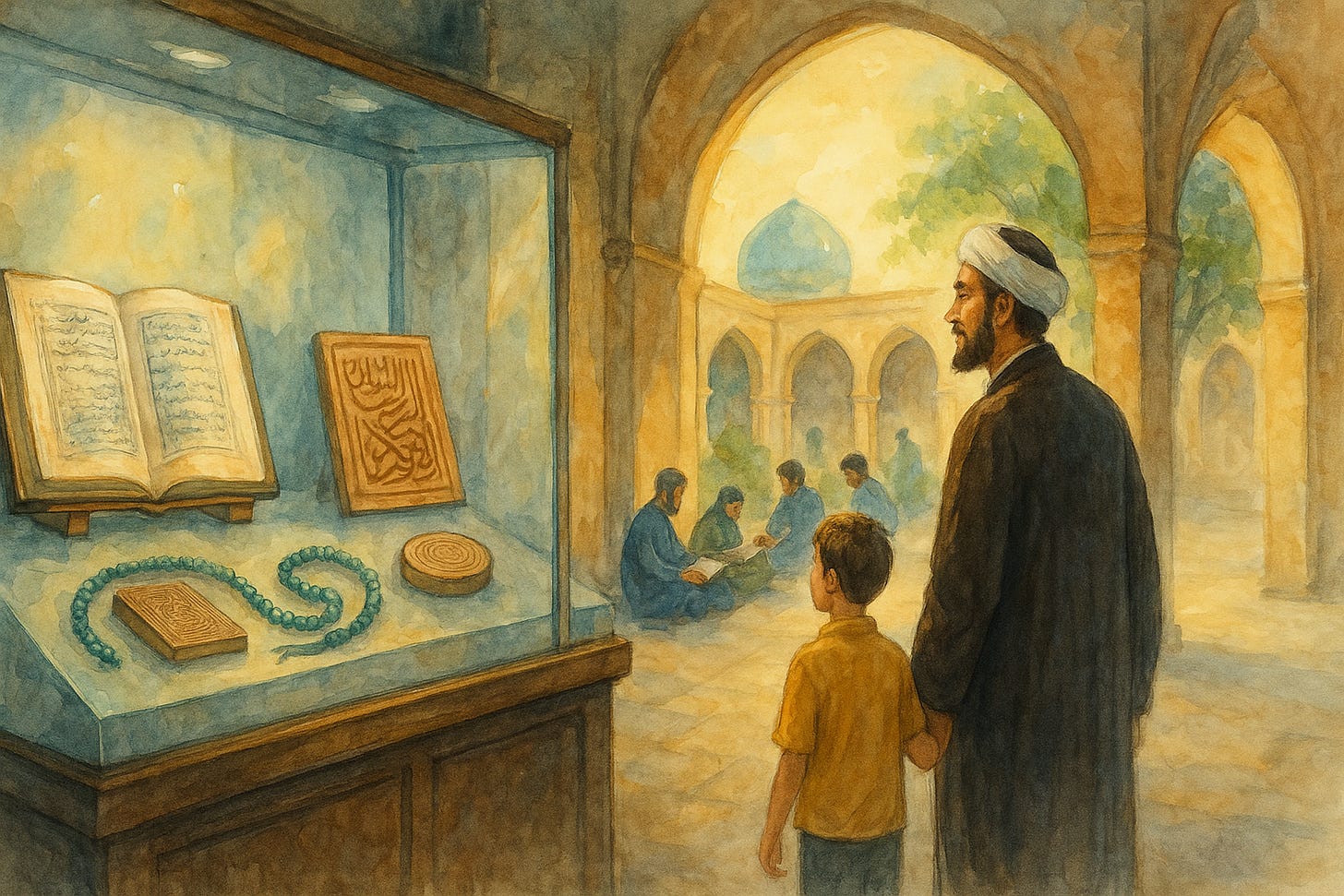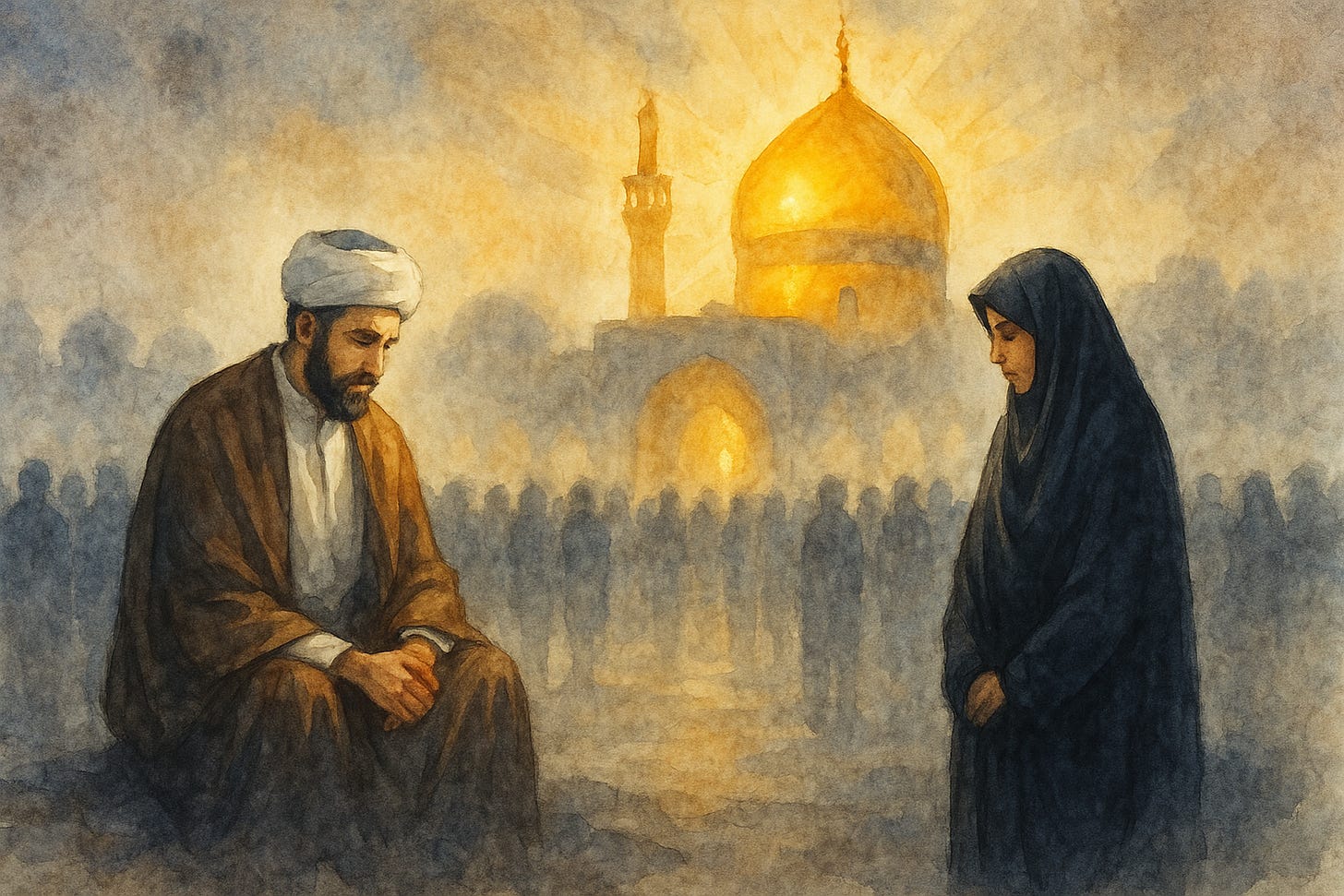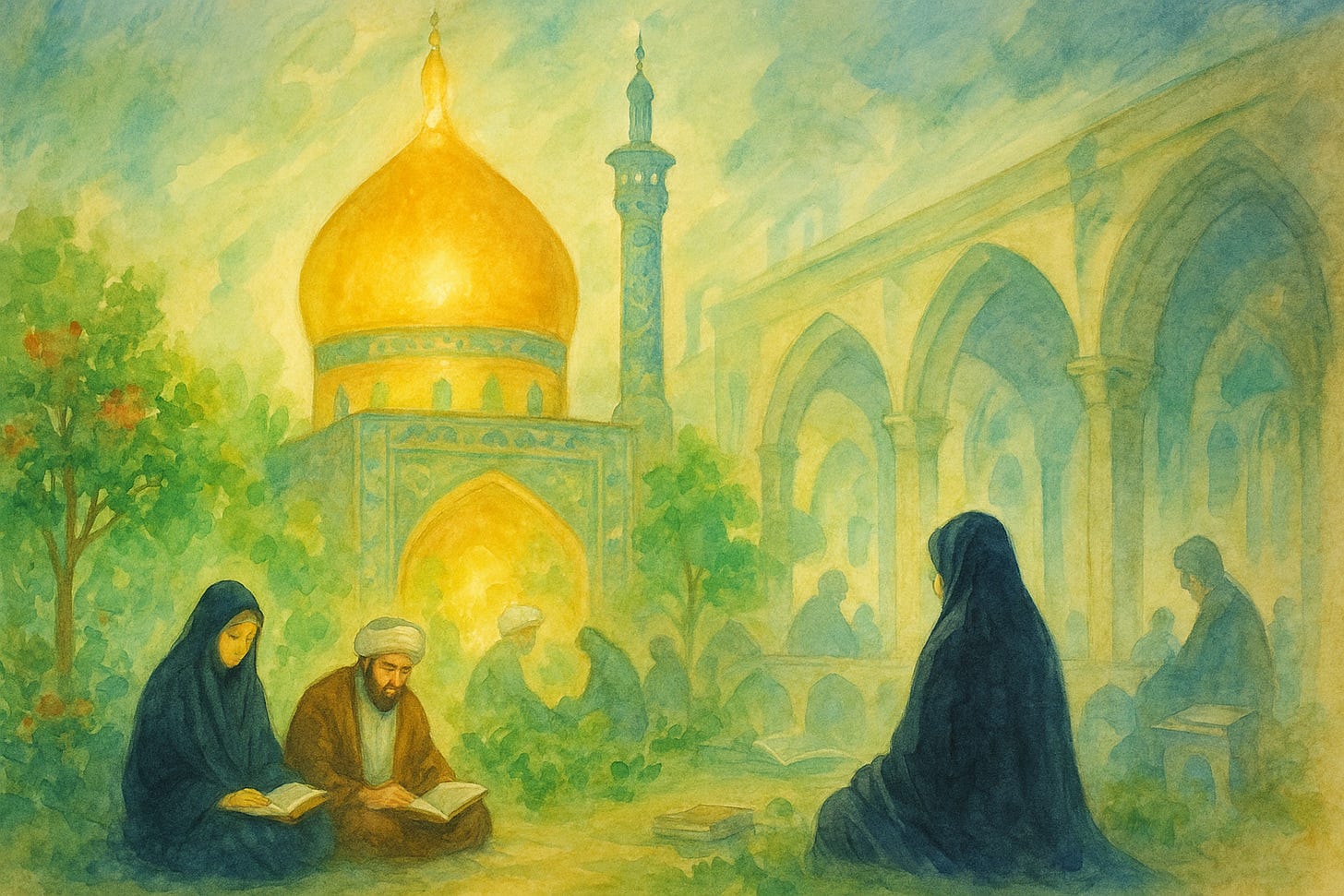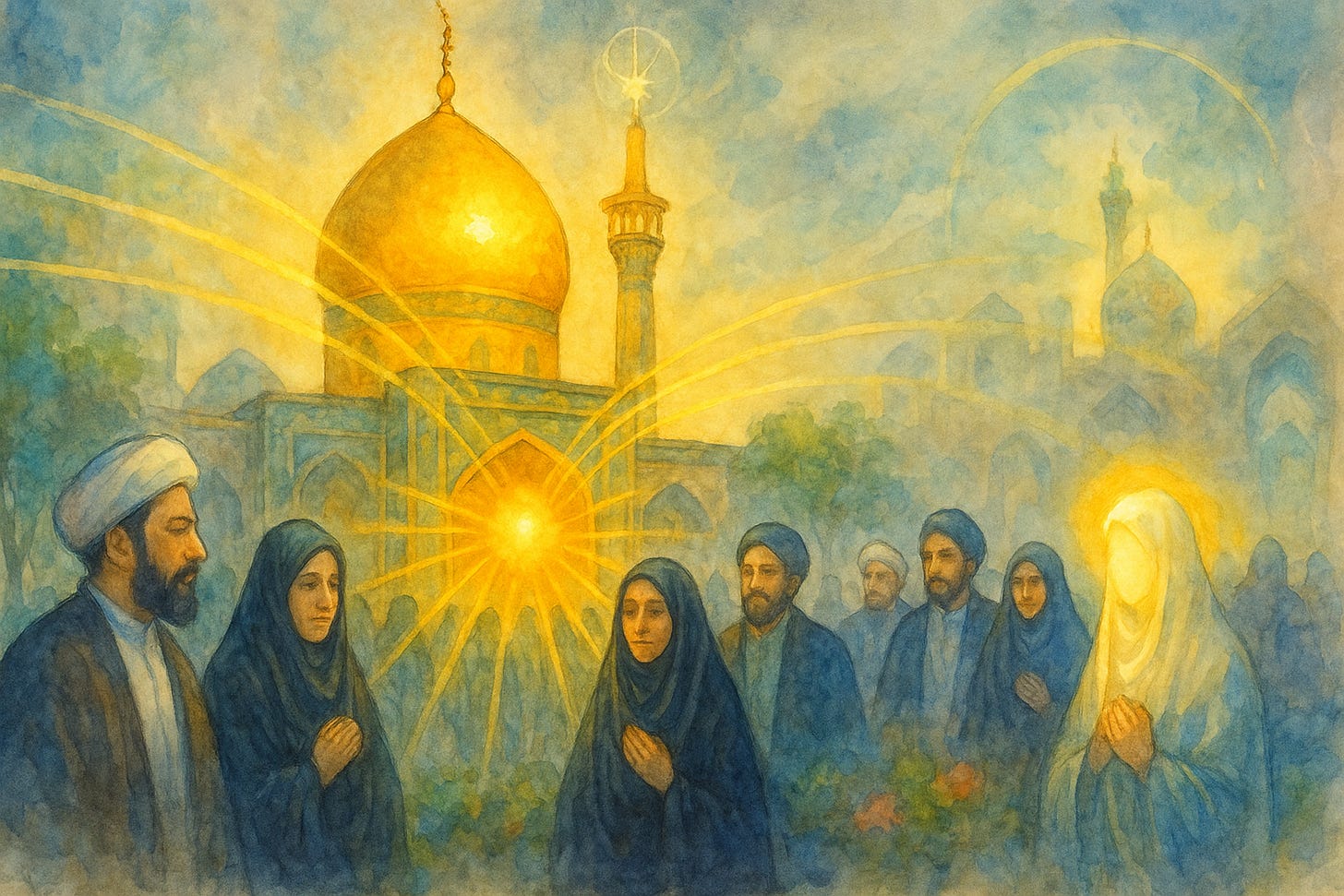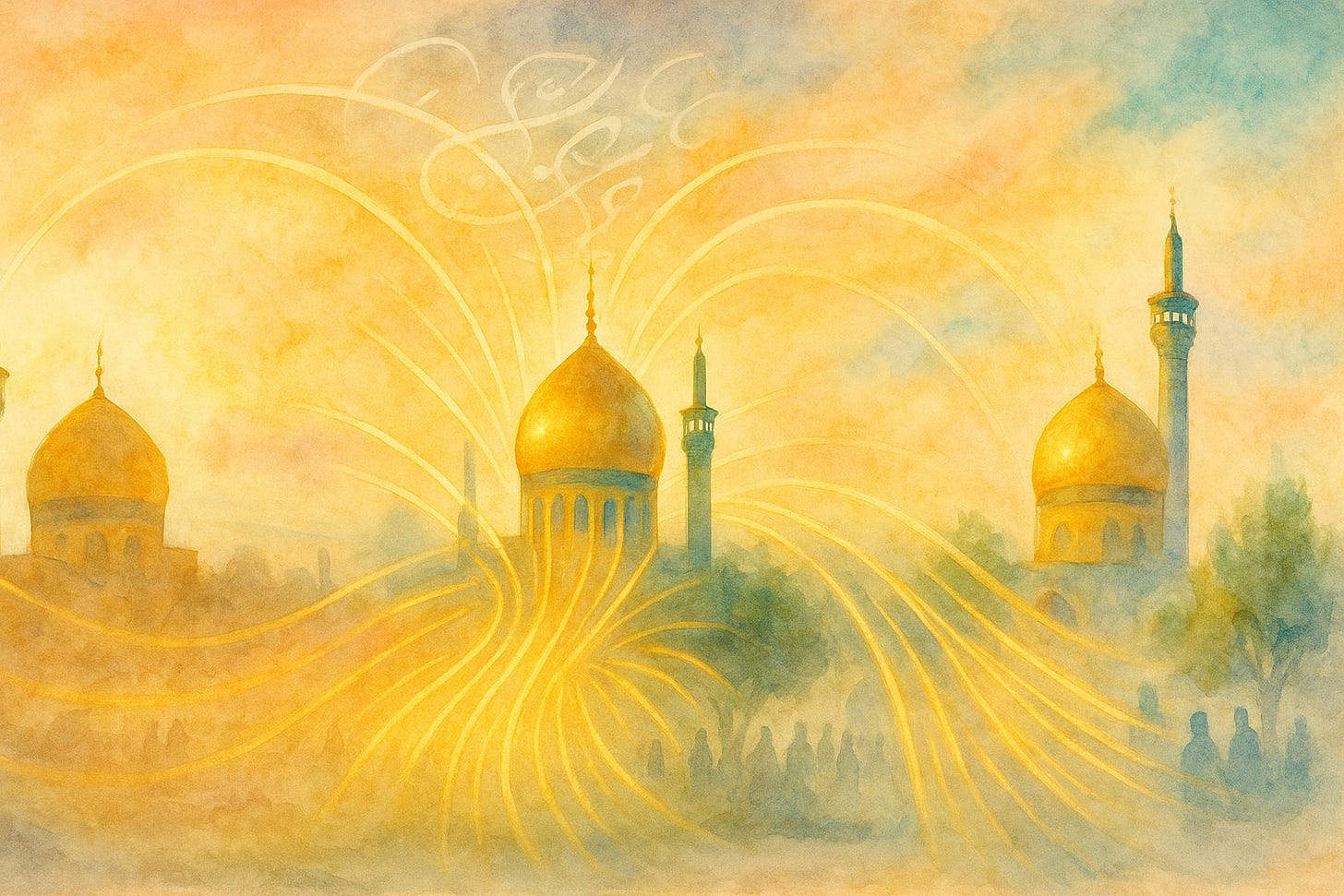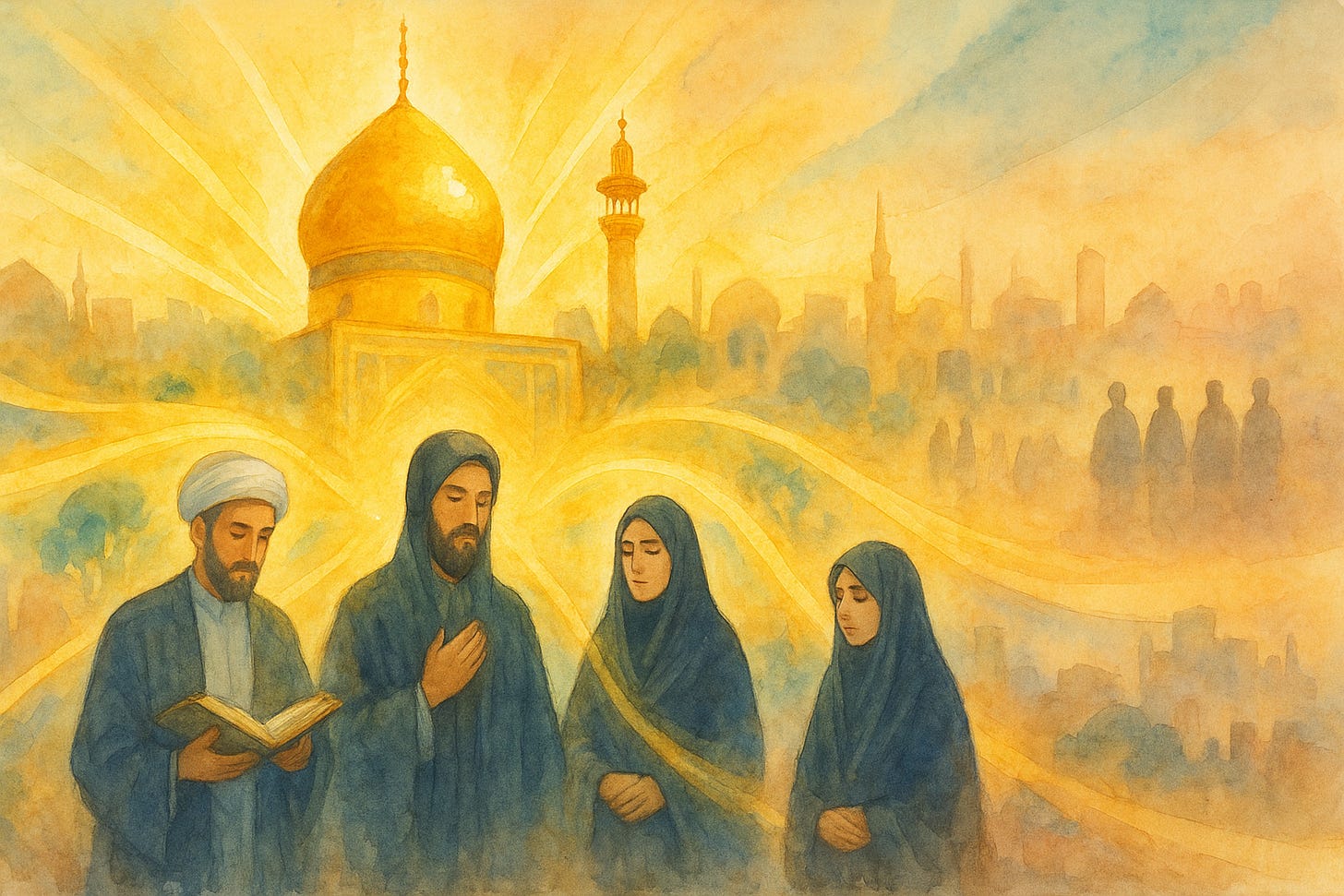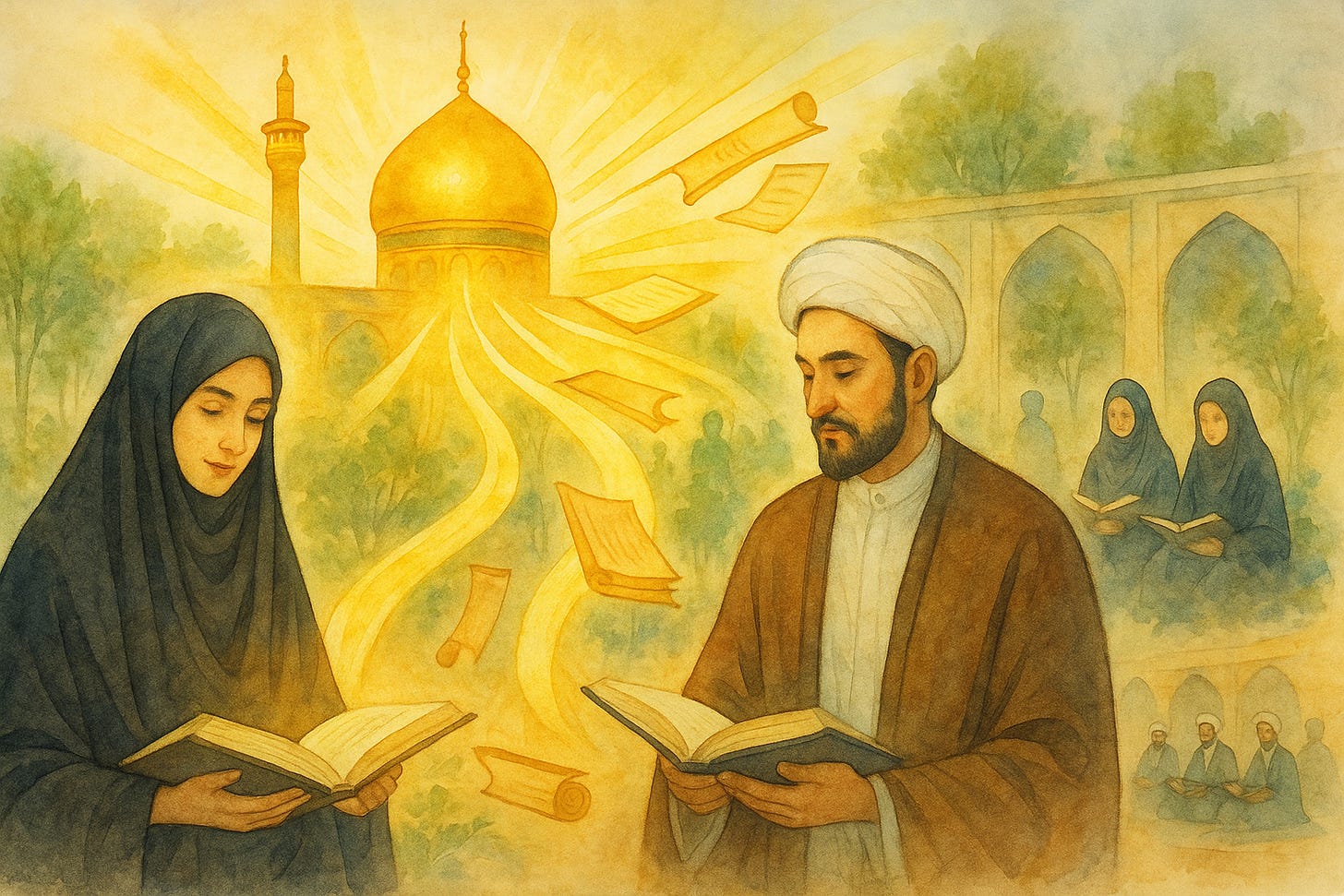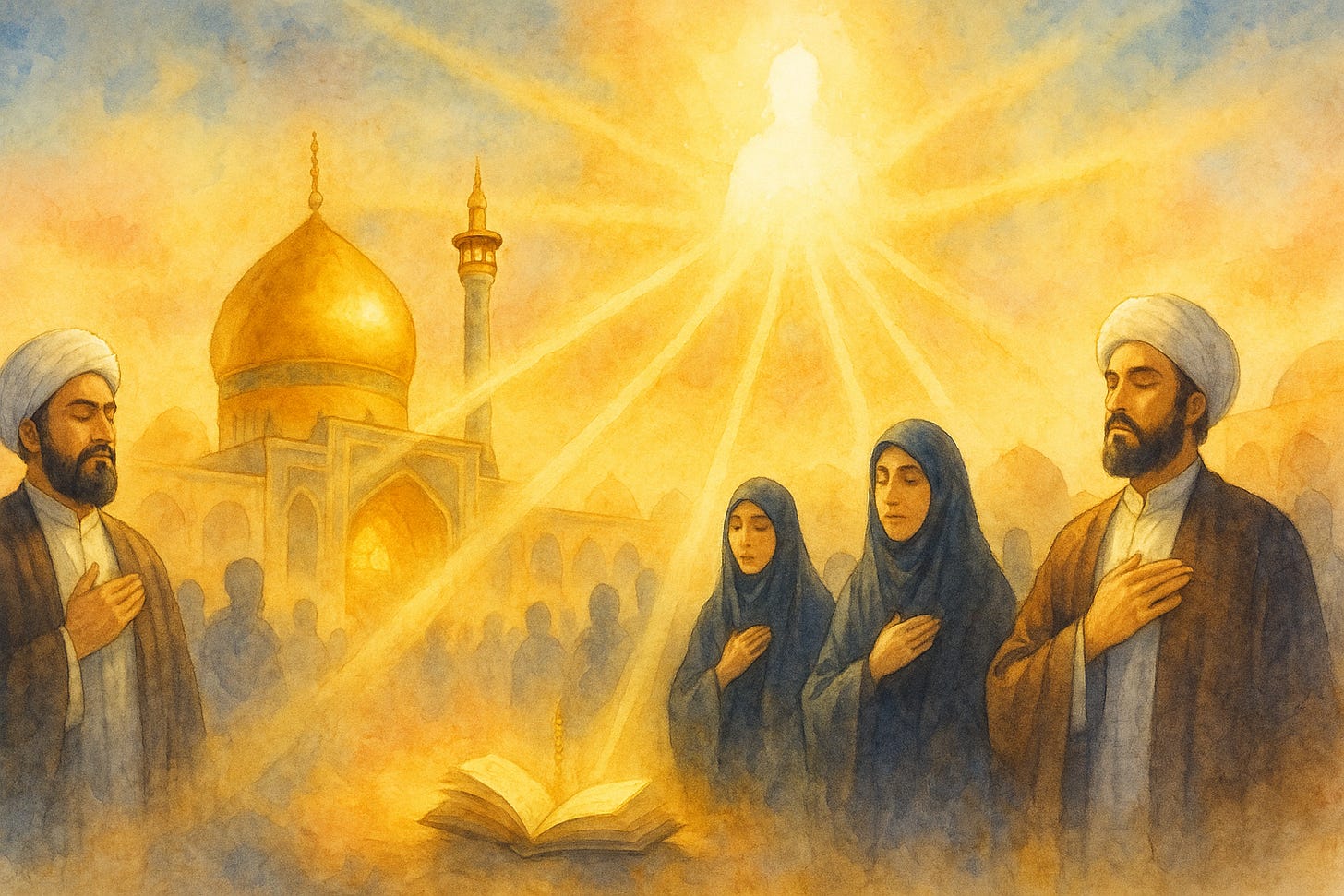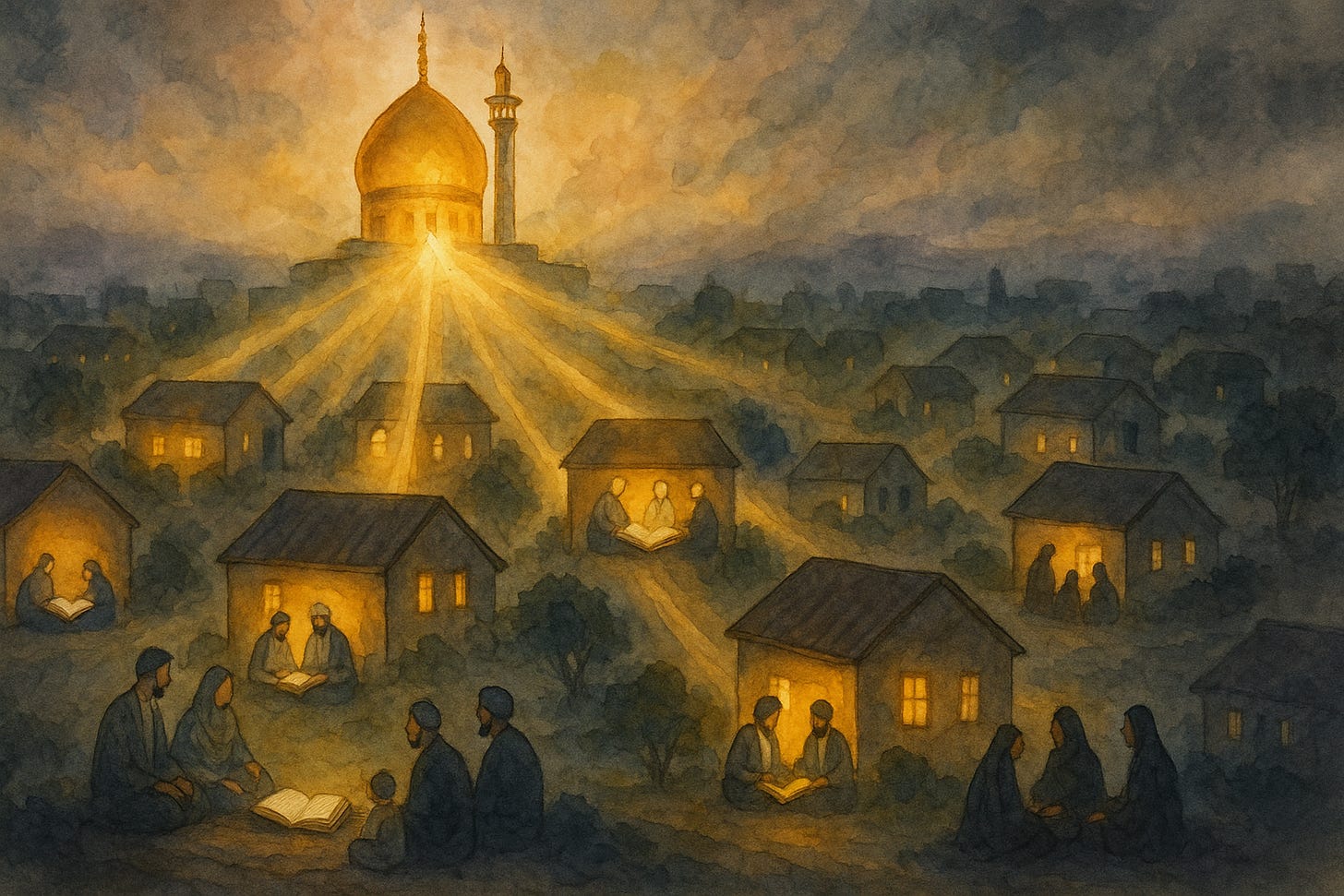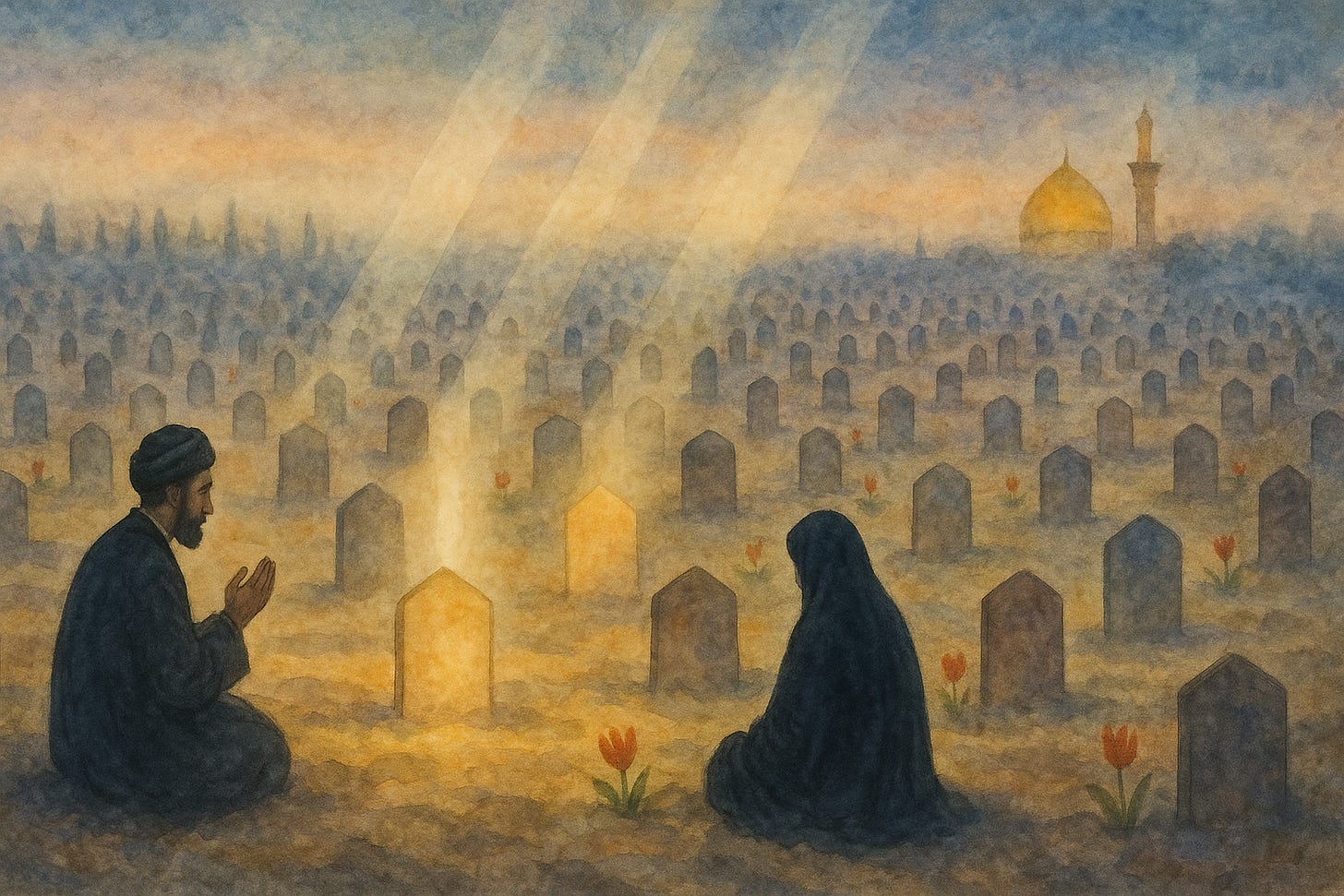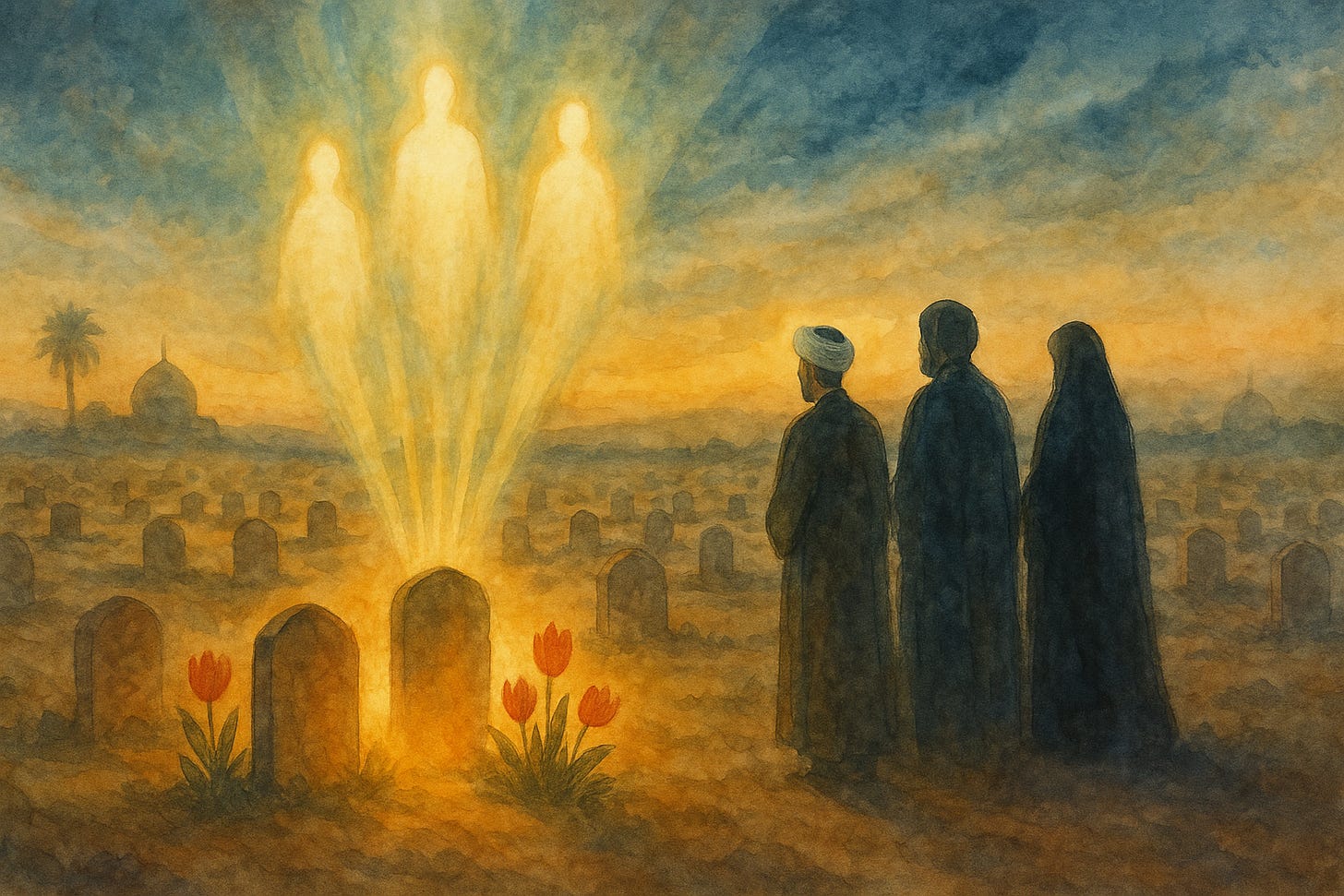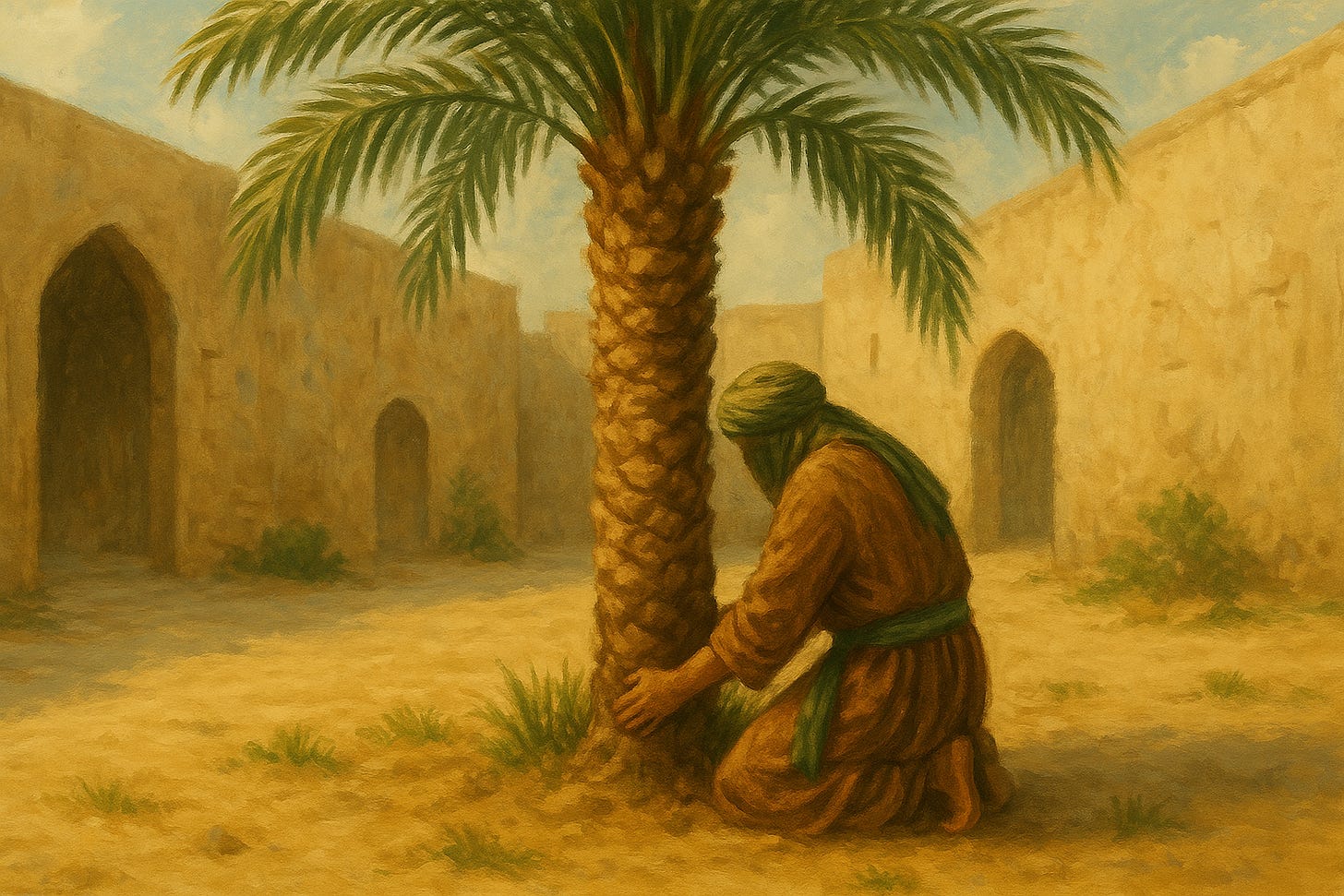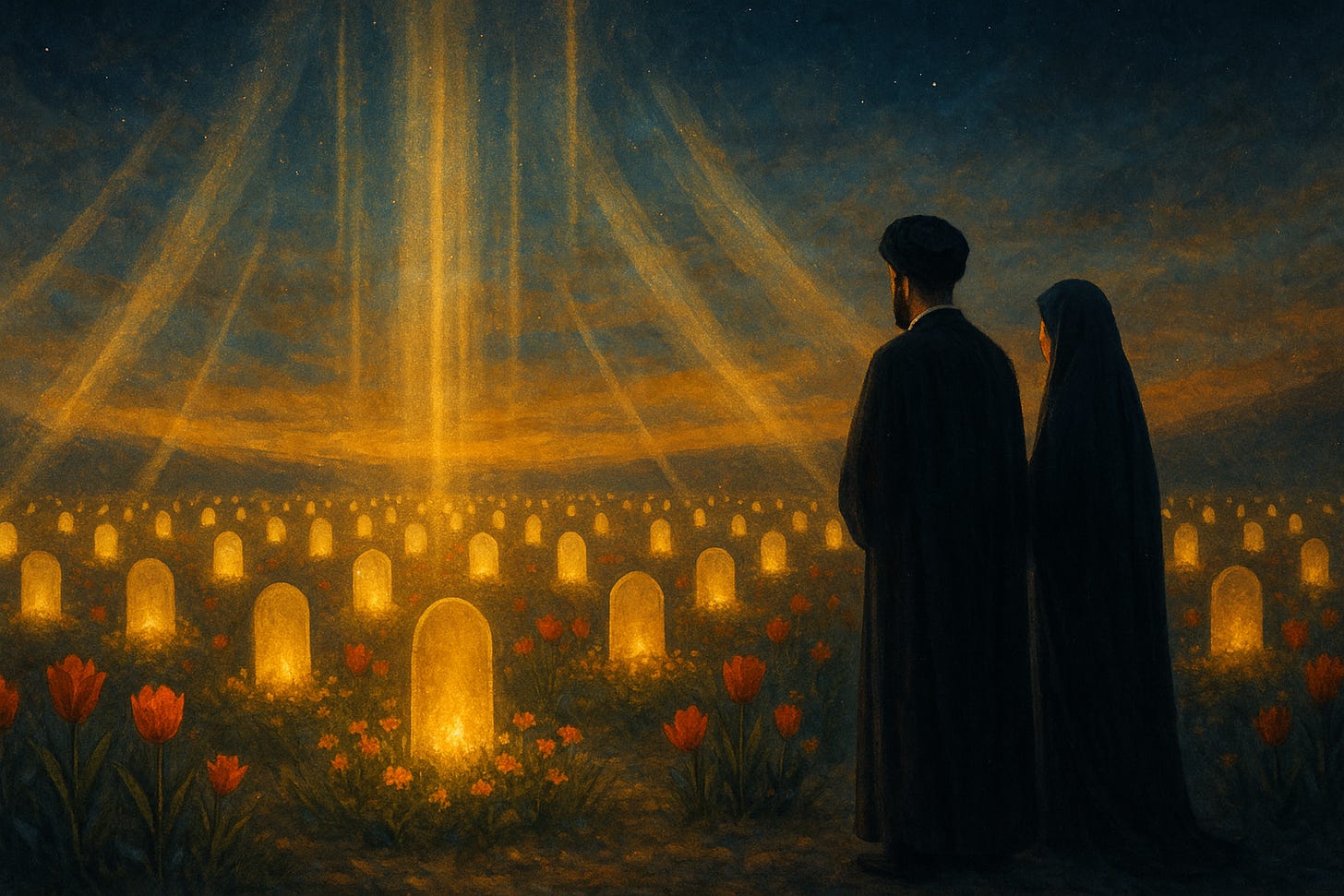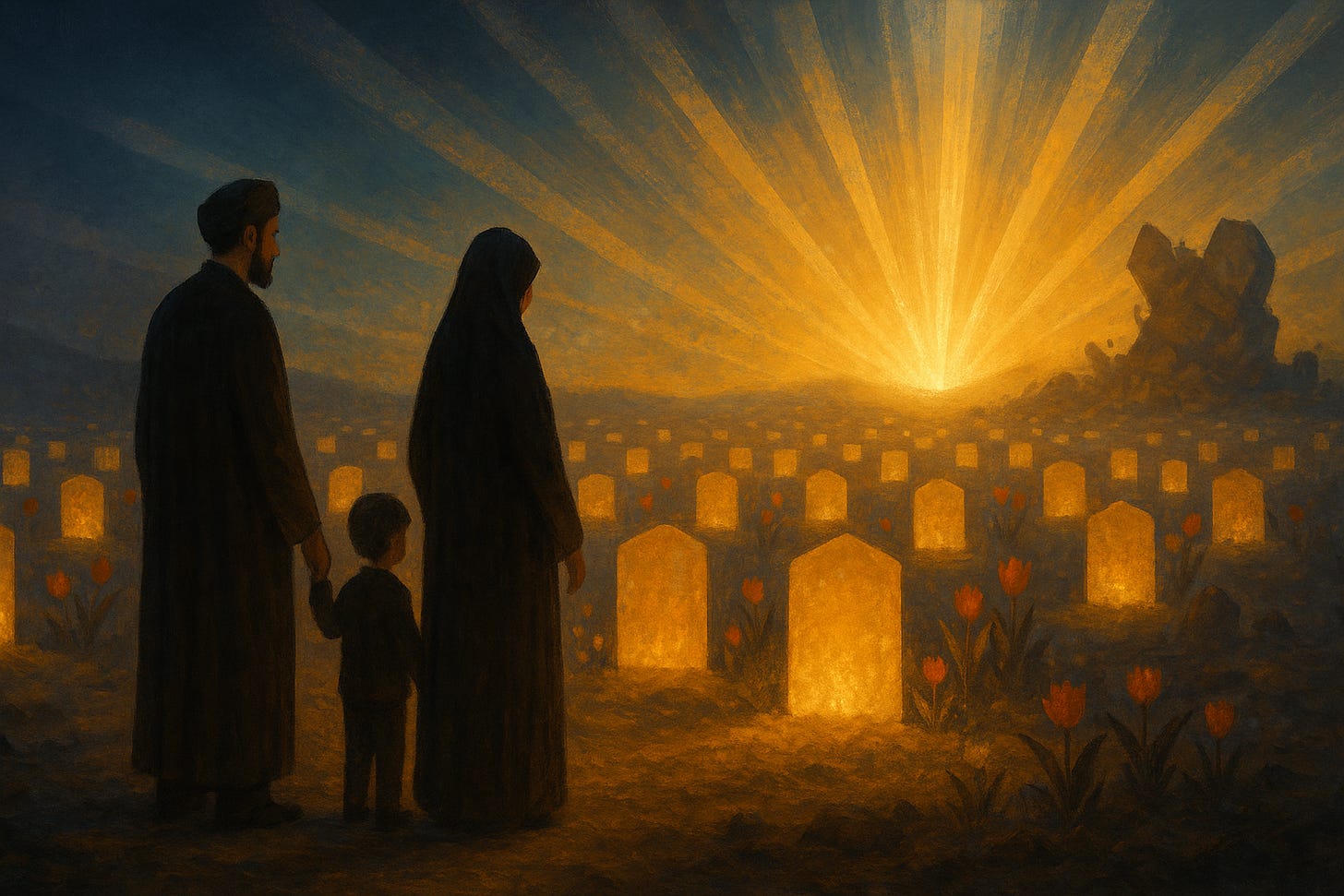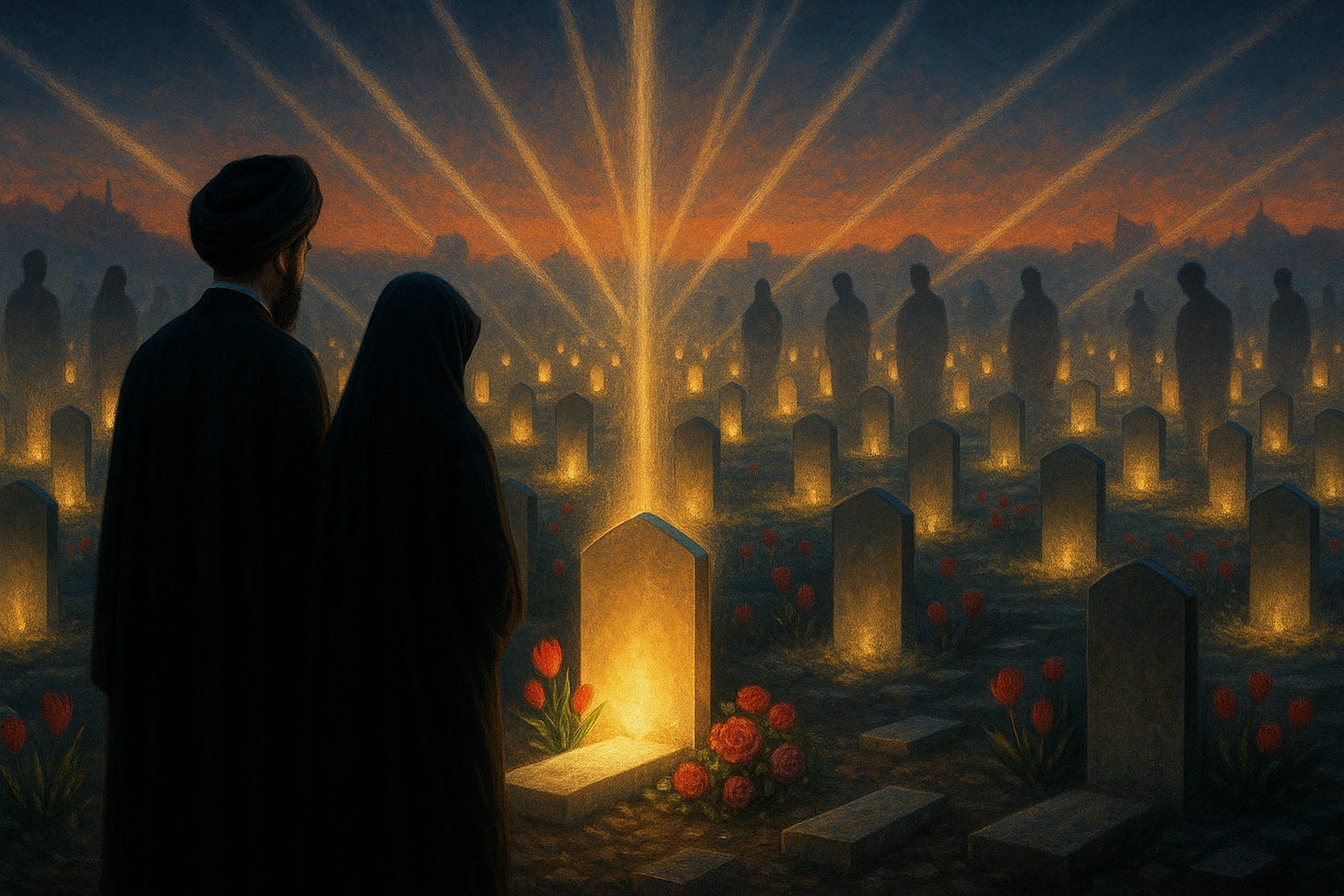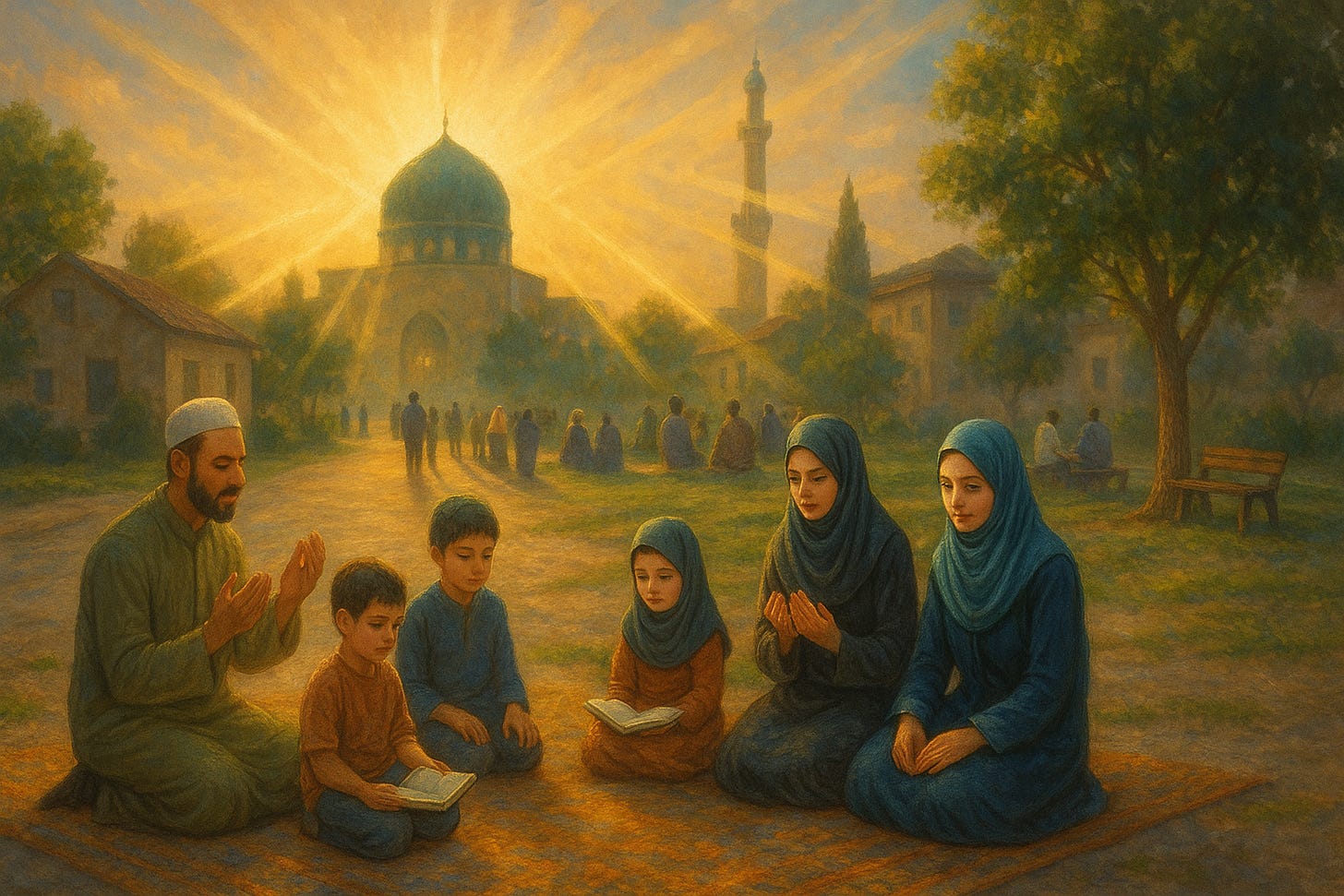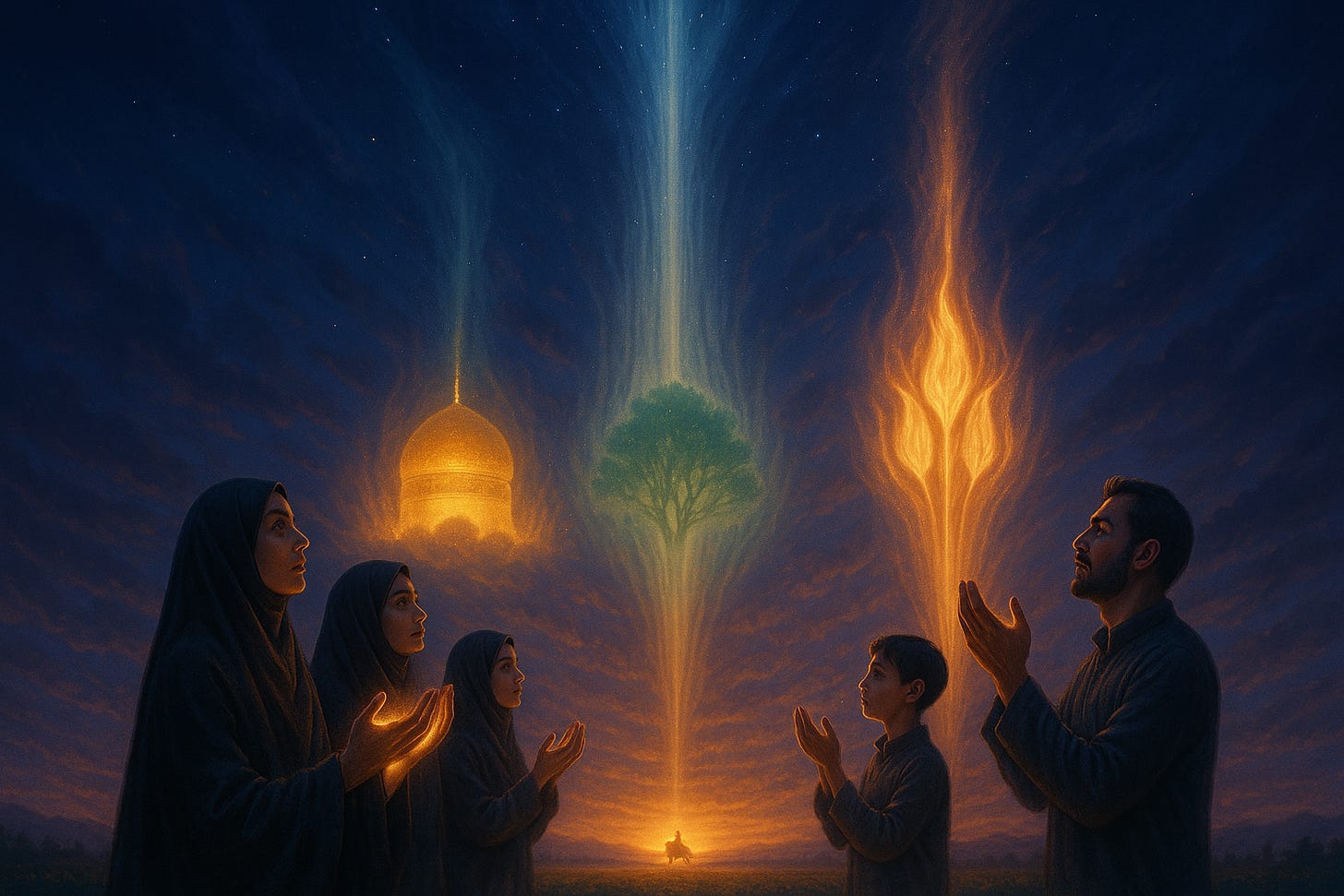[18] The Art of Supplication - The Sacred Windows: The Role of Place - Part 3 - The Sanctuary, The Saint, and The Sacrifice
A series of discussions based on the book Uddat al-Dai wa Najah as-Saee - The Provision of the Supplicant, and the Triumph of the Seeker by Ibn Fahd al-Hilli on the subject of Supplication and Prayer.
In His Name, the Most High
This is the eighteenth part of our series, The Art of Supplication, an ongoing exploration into the sacred relationship between the supplicant, the supplication, and the Divine.
The insights within this series are cumulative, and the nature of our discussion requires that each part build upon foundations laid in the ones that came before.
To prevent any misunderstanding and to fully benefit from the depth of this subject, it is essential that you engage with the previous parts in order before continuing with this one.
The previous parts in this series can be found here:
Video of the Majlis (Sermon/Lecture)
This write up is a companion to the video majlis (sermon/lecture) found below:
Audio of the Majlis (Sermon/Lecture)
This write up is a companion to the audio majlis (sermon/lecture) found below:
Recap
The Crucible, The Criterion, and The Citadel
In our last session, we journeyed through the sacred windows of place to the heartland of Iraq, exploring a triangle of trial, testimony, and trust that has forged the very resolve of our faith.
Our path began in Kufa, which we called the Crucible of the Covenant. There, we confronted the painful lessons of hesitation and the vast chasm between passive admiration and the active allegiance (bay’ah) demanded by the Imam of the time. Kufa stands as an eternal warning against a faith of words without deeds.
From Kufa’s difficult question, we traveled to its definitive and bloody answer: Karbala, the Criterion of Truth. On that pre-ordained sanctuary, we learned the grammar of wilayah, written in the sacrifice of Imam Husayn. Karbala taught us that true love for the oppressed (salam) is inseparable from a clear and courageous disavowal of the oppressor (bara’ah).
Our journey through this triangle concluded in Najaf, the Citadel of Preservation. Around the luminous gate of all prophetic knowledge, Imam Ali, we found the fortress of guardianship.
Here, the passion of Karbala is protected and transmitted across generations through the disciplined scholarship of the Hawza and the solemn covenant of the marja’iyyah.
Together, these three sanctuaries provided a profound syllabus in resolve, teaching us the price of the pledge, the power of the proof, and the structure of preservation.
But the school of the Ahl al-Bayt does not only forge the believer’s intellect and steel their resolve; it also softens, shapes, and heals the believer’s heart. Having understood the grammar of loyalty, where do we learn the poetry of mercy?
Tonight, our journey continues to the sacred sanctuaries of Iran...
In His Most beautiful name, we continue …
The Role of Place - Part 3 - The Sanctuary, The Saint, and The Sacrifice
Mashhad — The Sanctuary of Mercy (Rahmah)
Having journeyed through the syllabus of resolve in Iraq, our path now continues to the sacred sanctuaries of Iran, where the heart is healed, softened, and shaped.
We begin in Mashhad, a name that means “the place of martyrdom,” yet paradoxically, it has become one of the world’s greatest sanctuaries of life-giving mercy (rahmah).
Here rests the eighth Imam, Ali ibn Musa al-Ridha (peace be upon him), whose titles, history, and the very land upon which he rests, reveal the profound nature of his compassion and the ultimate verdict of history.
The Ocean of Mercy and the Verdict of History
The Imamate of Imam al-Ridha was a profound manifestation of God’s all-encompassing mercy, a quality the Qur’an establishes as a universal principle:
وَرَحْمَتِى وَسِعَتْ كُلَّ شَىْءٍ
“And My mercy encompasses all things.”
— Qur’an, Surah al-A’raf (the Chapter of the Heights) #7, Verse 156
The Prophet (peace be upon him and his family) was sent as the embodiment of this attribute, a “mercy to the worlds,” and the Imams are the inheritors of this prophetic rahmah.
This divine mercy is reflected in the extraordinary promises attached to the Imam’s ziyarah, a covenant of mercy that offers refuge on the day when no other refuge can be found.
The history of the shrine itself is a powerful lesson in this dynamic.
The land was originally a garden estate belonging to the governor of Tus, where the powerful Abbasid Caliph, Harun al-Rashid—the persecutor of the Imam’s father, Imam Musa al-Kadhim—was buried after his death.
Years later, Harun’s son, al-Ma’mun, in a final act of political theatre after martyring Imam al-Ridha with poison, buried the Imam in that very same garden, next to his own father.
Ma’mun’s intention was likely to subsume the Imam’s legacy under the shadow of Abbasid power.
History, however, delivered a different verdict.
Today, the magnificent golden dome of Imam al-Ridha stands as a global centre of pilgrimage, drawing tens of millions of hearts, while the tomb of the mighty Caliph Harun lies in an unmarked corner beneath it, almost entirely forgotten.
The place is known not as the tomb of the Caliph, but as the shrine of his victim.
Gharib al-Ghuraba and Dhamin al-Ahu: The Titles of Tenderness
Two titles of the Imam most beloved to his followers reveal the very essence of his compassionate guardianship.
Gharib al-Ghuraba: The Refuge for Every Estranged Soul
The title Gharib al-Ghuraba is often translated literally as “the Stranger of Strangers,” but its meaning is a deep ocean, reflecting the Imam’s lived reality and his spiritual station.
First, it speaks to his profound historical estrangement. He was forcibly exiled from his home in Madinah, politically isolated in a corrupt court, and ultimately martyred and buried far from his kin. The standard visitation prayer (ziyarah) for the Imam has the pilgrim bear witness to this painful reality, addressing him directly:
السَّلامُ عَلَيْكَ أَيُّهَا الإِمَامُ الغَرِيبُ... أَشْهَدُ أَنَّكَ قَدْ أَقَمْتَ الصَّلاةَ وَآتَيْتَ الزَّكاةَ وَأَمَرْتَ بِالْمَعْرُوفِ وَنَهَيْتَ عَنِ الْمُنْكَرِ وَعَبَدْتَ اللهَ مُخْلِصاً حَتّىٰ أَتاكَ الْيَقِينُ
“Peace be upon you, O the Stranger Imam... I bear witness that you established the prayer, gave the zakat, commanded the good, forbade the evil, and worshipped God with sincerity until certainty (death) came to you.”
— Shaykh Abbas al-Qummi, Mafatih al-Jinan, from the Ziyarah of Imam al-Ridha
Second, the title reflects a deep spiritual reality. The Imam, as the living embodiment of pure Islam in his time, was the ultimate manifestation of the state described by his great ancestor, the Prophet Muhammad (peace be upon him and his family):
إِنَّ الْإِسْلَامَ بَدَأَ غَرِيباً وَسَيَعُودُ غَرِيباً كَمَا بَدَأَ فَطُوبَى لِلْغُرَبَاءِ
“Indeed, Islam began as a stranger (gharib) and will return as a stranger as it began. So blessed are the strangers (al-ghuraba).”
— Al-Kulayni, Al-Kafi, Volume 8 (Al-Rawdah), Page 39, Hadeeth 1
Imam Khamenei, who was born and raised in Mashhad, explains that this “strangeness” was not just about being far from home, but about being a stranger to the falsehood and corruption of the caliph’s court.
He was a stranger because of his purity, his knowledge, and his unwavering divine connection in an environment of moral decay. The Leader has said:
معنای غربت امام رضا فقط این نیست که از مدینه دور بود. غربت اصلی، غربت معنوی بود: غربت ناشی از عدم وجود کسانی که قدر و منزلت آن معرفت الهی را بفهمند.
“The meaning of Imam al-Ridha’s estrangement (ghurbat) is not just that he was far from Madinah. The primary estrangement was spiritual: an estrangement caused by the absence of those who could comprehend the station and value of his divine knowledge.”
— Imam Khamenei, from his Nowruz speech on the life of Imam al-Ridha, delivered in Mashhad, Iran, March 21, 2007 (1 Farvardin 1386).
Finally, and most paradoxically, it is because he endured the pinnacle of all forms of estrangement that he became the ultimate providential refuge for every estranged soul.
The lonely find a friend in him, the exiled find a homeland in his sanctuary, and all who feel like strangers in this material world (dunya) find in him a compassionate guide who understands their pain.
His title, therefore, is not a statement of pity, but a declaration of his function as a universal sanctuary.
Dhamin al-Ahu: The Guarantor of the Vulnerable
This protective compassion is beautifully captured in the story of the Zamin-e-Ahoo (in Persian) or Dhamin al-Ahu (in Arabic).
Shaykh al-Saduq provides the core of this widely transmitted event:
رُوي أن الإمام الرضا (ع) رأى صياداً قد اقتنص ظبية، فنظرت إليه الظبية وكلمته بكلام يفهمه. فقال للصياد: أطلقها حتى تذهب فترضع خشفيها ثم تعود إليك. فقال الصياد: لا أفعل. فقال الإمام: أنا ضامن لها، فإن لم تعد، فلك حكمك عليّ. فأطلقها الصياد، فذهبت الظبية وأرضعت أولادها وعادت. فلما رآها الصياد، ذهل وأطلقها إكراماً للإمام.
It is narrated that Imam al-Ridha (peace be upon him) saw a hunter who had captured a doe. The doe looked at the Imam and spoke to him in a language he could understand.
He said to the hunter, “Release her so that she may go and nurse her fawns, and then she will return to you.”
The hunter said, “I will not do it.”
The Imam replied, “I will be her guarantor (dhamin). If she does not return, then you may pass your judgment upon me.”
The hunter released her, and the doe went, nursed her young, and returned.
When the hunter saw her, he was astonished and set her free in honour of the Imam.
— This is a widely transmitted narration. Its essence is attributed to Shaykh al-Saduq in Uyun Akhbar al-Ridha and is famously recounted by later scholars, including Allamah al-Majlisi in Bihar al-Anwar, Volume 49, Chapter 7 (On His Miracles)
This is more than a story; it is a theological principle.
The great contemporary scholar, jurist, gnostic and philosopher, Ayatullah Jawadi-Amoli, explains its deeper meaning:
ضمانت آهو توسط امام رضا (ع) تنها یک حادثه تاریخی نیست، بلکه تجلی رحمت فراگیر اوست که خود مظهری از رحمت واسعه الهی است. او پناه هر ضعیف و امان هر ترسانی است.
“The Imam’s guarantee of the deer is not merely a historical incident; it is a manifestation of his all-encompassing mercy, which is itself a reflection of God’s vast mercy. He is a refuge for every weak being and a sanctuary for every fearful soul.”
— Ayatullah Abdollah Jawadi-Amoli, from his commentary series on the lives of the Imams, Sirat-e Pishvayan (The Conduct of the Leaders), Volume on Imam al-Ridha, Page 142.
Just as Imam al-Ridha stood as a guarantor for a vulnerable deer, his Wilayah serves as a guarantee and a sanctuary for all who seek his refuge.
The Living Institution: From Custodianship to Revolution
The rahmah of Imam al-Ridha is not confined to a spiritual feeling or a future promise; it is a living, breathing, and active force in the world today.
This is manifested through the institution of Astane-ye Quds Razavi, the massive charitable and religious endowment that administers his shrine.
For centuries, this foundation has used the wealth donated in the Imam’s name to serve the people, building hospitals, universities, libraries, and providing for the poor.
The shrine is also the heart of the Hawza (Islamic Seminary) of Mashhad, one of the three great pillars of Shia scholarship alongside Najaf and Qom.
This mission of service was embodied by one of its most notable recent custodians, the martyred president of Iran, Sayyed Ibrahim Raisi.
Before his presidency, during his tenure as the head of Astane-ye Quds Razavi, he re-centred its mission on its foundational purpose: serving the downtrodden (mustadafin).
He famously stated:
خدمت به زائران و مجاوران، بهویژه نیازمندان، محور اصلی فعالیتهای آستان قدس رضوی است. این آستان باید پناهگاه محرومان باشد.
“Service to the pilgrims and the residents, especially the needy, is the central axis of the activities of Astane-ye Quds Razavi. This threshold must be the sanctuary for the deprived.”
— Sayyed Ibrahim Raisi, from a speech outlining his vision as Custodian of Astan Quds Razavi, Mashhad, Iran, March 13, 2016 (23 Esfand 1394)
This institutional mercy took on a decisive role following the victory of the Islamic Revolution.
When the newly formed Islamic Republic was struggling for survival, especially during the eight-year imposed war, the immense resources of Astane-ye Quds Razavi were mobilised to support the nation.
This was not a political decision, but a theological one.
It was a manifestation of the Imam’s ongoing wilayah and support for his followers.
As Imam Khamenei, who was born and raised in Mashhad, has affirmed, the shrine is not just a place of worship but a bastion of the revolution:
آستان قدس رضوی، در دوران انقلاب و دفاع مقدس، یکی از پایگاههای مهم پشتیبانی معنوی و مادی بود. این روحیه خدمت و جهاد، از برکات این بارگاه منور است.
“Astane-ye Quds Razavi, during the period of the Revolution and the Sacred Defence, was one of the most important bases of spiritual and material support. This spirit of service and jihad is from the blessings of this luminous shrine.”
— Imam Khamenei, from a speech delivered in the courtyard of the Holy Shrine of Imam al-Ridha, Mashhad, Iran, March 21, 2017 (1 Farvardin 1396)
This teaches us a profound lesson: the Imam, though physically absent, is never passive. His mercy and guardianship continue to flow through the institutions built in his name, providing tangible support and protection for those who uphold the banner of his cause.
Calls to Clarify: Lessons from the Guarantor
The mercy of Imam al-Ridha is not something we merely visit; it is something we are called to embody. The adab — etiquette — of his ziyarah and the history of his shrine are a training in this very embodiment.
Clarify Your Mercy: Become a Guarantor for All the Vulnerable.
The story of Dhamin al-Ahu is a profound lesson in both the scope and the nature of Islamic compassion.
It teaches that Ridawi mercy is not reserved for believers alone but extends to all vulnerable beings, even an animal. More importantly, it teaches that this mercy is not a passive feeling but an active guardianship.
The Imam (peace be upon him) did not just feel sorry for the deer; he put himself on the line and became its guarantor (dhamin).
This is our model.
In a world that systematically dehumanises the vulnerable, our duty is to become guarantors for those who have no protector: for the children and the oppressed in Gaza, for the unborn child whose sacred life is dismissed as an “inconvenience,” and for our elders who are encouraged to accept euthanasia because a failed system deems their care a burden.
When the world encourages killing, we must be those who stand firm and say no. We choose life over death and dignity over humiliation. We choose instead to use both wings of our loyalty to soar towards God, towards Truth, towards true Perfection.
Clarify the Verdict of History: The Enduring Light vs. the Vanished Tyrant
The physical reality of the shrine—the glorious dome of the Imam overshadowing the forgotten grave of the Caliph—is a powerful clarification.
Worldly power is fleeting, while the light of divine guardianship is eternal.
This teaches us to align ourselves with the enduring axis of truth, not with the transient powers of our time.
It is a call to place our trust in the promises of God, which are manifest in His awliya, rather than in the promises of arrogant and fleeting empires.
Clarify Your Heritage: From Artefacts to Action
The magnificent museums of the shrine are not merely collections of old objects; they are a clarification of our identity.
They preserve the material culture of our faith as a trust.
Our duty is not just to admire these artefacts, but to become living artifacts of our faith.
To take part in the mission of the Hawza is to embark on a journey towards God and the Ahl al-Bayt.
This path is defined by the pursuit of knowledge, the embodiment of Islamic ethics (akhlaq), and the solemn duty to preserve the intellectual and spiritual heritage of the Ahl al-Bayt, a legacy we uphold in our own lives and pass on to our children.
Clarify Your Solitude: Embracing the Blessing of Estrangement
Many sincere believers feel like strangers (ghuraba) in their own communities when they witness corruption and hypocrisy.
Your feeling of estrangement is not a sign of weakness, but a sign that your heart is still alive to the truth.
You are sharing, in a small way, the very spiritual state of your Imam.
You are living the reality of the hadith:
إِنَّ الْإِسْلَامَ بَدَأَ غَرِيباً وَسَيَعُودُ غَرِيباً كَمَا بَدَأَ فَطُوبَى لِلْغُرَبَاءِ
“Indeed, Islam began as a stranger (gharib) and will return as a stranger as it began. So blessed are the strangers (al-ghuraba).”
— Al-Kulayni, Al-Kafi, Volume 8 (Al-Rawdah), Page 39, Hadeeth 1
This ghurbat (loneliness) is a blessing (tuba), a badge of honour.
It is proof that you have not accepted defeat, nor allowed your heart to become numb to falsehood.
And know that for every soul who feels this sacred loneliness, the divinely-appointed refuge and the gate to God’s ultimate solace is the Master of Strangers himself, Imam Ali ibn Musa al-Ridha (peace be upon him).
Qom — The Garden of Intercession and Loyalty
From the ocean of the Imam’s mercy in Mashhad, our journey now takes us to the garden of his beloved sister, the holy city of Qom.
If Mashhad is a testament to the Imam’s compassionate embrace, Qom is a testament to the power of a single woman’s unwavering loyalty to her Imam. Here, the grave of Sayyedah Fatimah al-Ma’soumeh (peace be upon her) did not mark an end; it planted a seed that grew into one of the world’s most influential fortresses of Shia knowledge, proving that in the school of the Ahl al-Bayt, feminine sanctity can shape civilisations.
Karimat Ahl al-Bayt and the Power of Intercession
Sayyedah Ma’soumeh is known by the unique and revered title of Karimat Ahl al-Bayt—the Noble and Generous Lady of the Household of the Prophet.
This title signifies her immense spiritual station and her role as a conduit of divine generosity.
Her ziyarah is not just a visit, but an entry into a covenant of intercession (shafa’ah).
Her brother, Imam al-Ridha (peace be upon him), established her station with his famous declaration:
مَنْ زَارَ الْمَعصُومَةَ بِقُمّ كَمَنْ زَارَني
“Whoever visits al-Ma’soumeh in Qom is like one who has visited me.”
— Al-Majlisi, Bihar al-Anwar, Volume 99, Kitab al-Mazar (The Book of Pilgrimage), Chapter 7 on the Ziyarah of Fatimah bint Musa, Page 267, Hadeeth 4
The theology of intercession is central to understanding Qom.
It is not a circumvention of divine justice, but a divinely-appointed means of drawing closer to God’s mercy.
The Qur’an affirms that no intercession is possible except by His leave, highlighting that it is a station granted by God Himself:
مَن ذَا ٱلَّذِى يَشْفَعُ عِندَهُۥٓ إِلَّا بِإِذْنِهِ
“Who is it that can intercede with Him except by His permission?”
— Qur’an, Surah al-Baqarah (the Chapter of the Cow) #2, Verse 255
The Ahl al-Bayt are the foremost of those granted this permission.
The great scholar and martyr, Ayatullah Murtadha Mutahhari, masterfully clarified this very point.
He explained that intercession is a powerful educational and spiritual tool designed to prevent despair and inspire reform. He wrote:
فلسفه شفاعت، تربیت و اصلاح است نه تشویق به گناه. شفاعت یک عامل بازدارنده در برابر یأس از رحمت الهی است. گناهکار را در حالتی میان خوف و رجا نگه میدارد و به اصلاح خویش امیدوار میسازد.
“The philosophy of intercession (shafa’ah) is one of training (tarbiyyat) and reform, not an encouragement to sin.
Intercession is a preventative factor against despairing of God’s mercy.
It keeps the sinner in a state between fear (khawf) and hope (raja’), and makes them hopeful of their own reform.”
— Ayatullah Murtadha Mutahhari, Adl-e Ilahi (The Divine Justice), Section on Intercession, Page 261
Therefore, visiting Sayyedah Ma’soumeh with this understanding transforms the ziyarah from a plea for personal favours into a renewal of one’s own loyalty to the Imamate she represents.
We seek her intercession not as an escape from our duties, but as a source of divine help and empowerment to fulfil them.
The Prophesied Seminary: From Najaf to Qom
For over a thousand years, the Hawza of Najaf was the undisputed heart of Shia scholarship.
However, the Imams of the Ahl al-Bayt prophesied that another city would one day carry this sacred trust.
In a stunning and widely-cited narration, Imam Ja’far al-Sadiq (peace be upon him) foretold the central role of Qom in the era of the occultation:
سَيَأْتِي زَمَانٌ تَكُونُ بَلْدَةُ قُمَّ وَأَهْلُهَا حُجَّةً عَلَى الْخَلَائِقِ... فَيُفِيضُ الْعِلْمُ مِنْهُ إِلَى سَائِرِ الْبِلَادِ فِي الْمَشْرِقِ وَالْمَغْرِبِ، فَيَتِمُّ حُجَّةُ اللَّهِ عَلَى الْخَلْقِ.
“A time will come when the city of Qom and its people will be a proof (hujjah) over all of creation... Then, knowledge will overflow from it to all other lands in the East and the West, and thus the proof of God will be complete over His creation.”
— Al-Majlisi, Bihar al-Anwar, Volume 57, Kitab al-Tarikh (The Book of History), Chapter 36 on the Merits of Qom, Page 213, Hadeeth 60
In another, more specific narration concerning the transfer of knowledge from the city of Imam Ali (Kufa/Najaf), Imam al-Sadiq (peace be upon him) is reported to have said:
سَتَخْلُو كُوفَةُ مِنَ الْمُؤْمِنِينَ وَيَأْزِرُ عَنْهَا الْعِلْمُ كَمَا تَأْزِرُ الْحَيَّةُ فِي جُحْرِهَا ثُمَّ يَظْهَرُ الْعِلْمُ بِبَلْدَةٍ يُقَالُ لَهَا قُمُّ وَتَصِيرُ مَعْدِناً لِلْعِلْمِ وَالْفَضْلِ
“Kufa will one day be emptied of the believers, and knowledge will withdraw from it as a snake withdraws into its hole. Then, knowledge will appear in a land called Qom, and it will become a mine of knowledge and virtue.”
— Shaykh Abbas al-Qummi, Safinat al-Bihar, Volume 7, Page 345
One of the great pillars of the modern Qom seminary, the late philosopher and jurist Ayatullah Muhammad-Taqi Misbah-Yazdi, saw this hadith as a key to understanding the spiritual reality behind the Islamic Revolution.
He explained that the historical circumstances that weakened Najaf and strengthened Qom were not a mere accident, but the unfolding of this divinely-ordained plan:
این روایات نشان میدهد که مرکزیت علمی شیعه، به تقدیر الهی، از نجف به قم منتقل میشد تا زمینهساز یک تحول جهانی گردد. انقلاب اسلامی ایران، تحقق همین وعدههای معصومین بود که از دل حوزه علمیه قم جوشید.
“These narrations show that the academic center of Shi’ism, by divine decree, was destined to transfer from Najaf to Qom in order to prepare the ground for a global transformation.
The Islamic Revolution of Iran was the realisation of these very promises of the Infallibles, which erupted from the heart of the seminary of Qom.”
— Ayatullah Muhammad-Taqi Misbah-Yazdi, from his book Enghelab-e Islami: Jastari dar Risheshenasi-ha (The Islamic Revolution: An Inquiry into its Roots), which compiles his lectures on this topic, Qom, Iran, circa 1999
This divine prophecy was fulfilled in the 20th century.
Due to the intense and brutal persecution of scholars in Iraq under the Ba’athist regime in the 1970s, the Hawza of Najaf was decimated.
Many of its greatest scholars were imprisoned, martyred, or forced into exile.
It was during this dark period that the Hawza of Qom, nurtured for decades by great scholars, began to absorb this legacy.
The victory of the Islamic Revolution in 1979, led by a son of the Qom seminary, Imam Khomeini, provided the stability and support for Qom to flourish and become the primary global centre for Shia scholarship, fulfilling the words of Imam al-Sadiq.
This was not a human rivalry, but the unfolding of a divine plan.
It is crucial to clarify that this prophetic fulfillment does not mean the Hawza of Najaf has become defunct.
Najaf, with its thousand-year legacy and the blessed presence of the Commander of the Faithful, remains a deep and revered ocean of sacred knowledge.
However, the historical circumstances of the last century meant that the primary global epicentre of scholarship, revolutionary thought, and the training of the new generation of ulema did indeed shift to Qom.
Ultimately, Najaf, Qom, and Mashhad are not rivals; they are the three great pillars that support the entire intellectual and spiritual edifice of the Shia world, each a center of learning par excellence.
Calls to Clarify: Lessons from the Karimah
The legacy of Sayyedah Ma’soumeh and the city founded upon her grave offers us profound lessons for our own time.
Clarify the Power of Feminine Sanctity
The Hawza of Qom, a global epicenter of traditionally male-dominated religious scholarship, was founded upon the grave of a woman.
This is a powerful clarification.
It teaches us that in Islam, spiritual authority and the power to shape civilization are not restricted by gender.
Sayyedah Ma’soumeh’s life is a testament to the station of women in the school of Ahl al-Bayt.
Our duty is to honour this legacy by actively supporting and creating spaces for women’s scholarship and leadership within our communities, recognising them as essential heirs to the knowledge of the Prophet’s household.
Clarify the Meaning of Intercession: A Call to Loyalty
To seek the shafa’ah (intercession) of Sayyedah Ma’soumeh is not to seek an escape from our responsibilities.
It is an act of tawassul—approaching God through His chosen friends—that is meant to empower us. Her intercession is for those who are loyal to her brother, the Imam — and to the line of Imamate, and to the one who sent the Aimmah.
Therefore, to truly ask for her help is to simultaneously pledge to live a life of wilayah, of principled loyalty to the Imam of our Time.
It is a prayer for strength to return to the path, not a license to leave or neglect it.
Clarify Your Community: Build “Mini-Qoms”
Just as Qom became a “school of loyalty” and a fortress of clear doctrine, our local communities are called to become “mini-Qoms.”
This means creating spaces—in our centres, our homes, and our online gatherings—that are dedicated to teaching and preserving clean doctrine (aqidah) in an age of confusion.
It means fostering a strong, unapologetic Shia identity rooted in the Qur’an and the Ahl al-Bayt.
It is to build small fortresses of principled resistance against the waves of cultural and political decay, ensuring our communities are sources of light, not echoes of the darkness.
The Graveyards of the Martyrs — The Pedagogy of Death
From the sanctuaries of mercy and loyalty in Mashhad and Qom, our journey now arrives at its most sobering and clarifying destination: the sacred gardens of the martyrs.
From the vast, ancient necropolis of Wadi al-Salam in Najaf to the revolutionary rows of Behesht-e Zahra in Tehran, from the earth surrounding the Master of Martyrs in Karbala to the humble local cemeteries that hold our own communities’ heroes, we stand on ground where the Qur’an’s most profound promise has been made manifest.
These are not places of endings, but classrooms of eternity, where the earth itself teaches us the true meaning of life by bearing witness to those who gave their lives for the Truth.
The Qur’anic Promise: A Pedagogy of Life and Witness
The foundation for understanding the station of the martyrs is a direct and powerful command from God to correct our entire perception of death and sacrifice.
The Qur’an orders a fundamental shift in our reality:
وَلَا تَحْسَبَنَّ ٱلَّذِينَ قُتِلُوا۟ فِى سَبِيلِ ٱللَّهِ أَمْوَٰتًۢا ۚ بَلْ أَحْيَآءٌ عِندَ رَبِّهِمْ يُرْزَقُونَ
“And never think of those who have been killed in the cause of God as dead. Rather, they are alive with their Lord, receiving provision.”
— Qur’an, Surah Aal-e-Imran (the Chapter of the Family of Imran) #3, Verse 169
While this verse refers to the highest station of those killed in battle, the school of the Ahl al-Bayt broadens our understanding of martyrdom.
The Arabic word for martyr, shaheed, comes from the same root as shahid, which means “witness.”
Therefore, a martyr is, above all, a witness—one whose entire life, and not just their death, bears testimony to the truth of God in the face of falsehood.
The great martyr and thinker, Ayatullah Sayyed Muhammad Baqir al-Sadr, explained this profound connection:
الشهيد هو الذي يكتب بدمه شهادته على حقيقة الرسالة، فيكون دمه حجة على الأجيال. ولكن الحياة التي تسبق الشهادة هي أيضاً شهادة.
“The martyr (shaheed) is the one who writes with his blood his testimony (shahadah) to the truth of the message, so that his blood becomes a proof (hujjah) for generations. But the life that precedes the martyrdom is also a testimony.”
— Ayatullah Sayyed Muhammad Baqir al-Sadr, from his introductory lectures on Islamic ideology, Al-Islam Yaqud al-Hayat (Islam Governs Life), delivered in Najaf, circa 1976
This profound understanding—that a life lived as a witness is itself a form of shahadah—is rooted directly in the teachings of the Prophet and his family.
The traditions teach that the gates of martyrdom are open to every sincere believer, and that even one’s sincere intention (niyyah) can elevate them to this station.
The Prophet (peace be upon him and his family) himself gave this incredible promise:
مَنْ سَأَلَ اللَّهَ الشَّهَادَةَ بِصِدْقٍ بَلَّغَهُ اللَّهُ مَنَازِلَ الشُّهَدَاءِ وَإِنْ مَاتَ عَلَى فِرَاشِهِ
“Whoever sincerely asks God for martyrdom, God will raise him to the stations of the martyrs, even if he dies on his bed.”
— Al-Hurr al-Amili, Wasa’il al-Shia, Volume 15, Kitab al-Jihad, Page 53, Hadeeth 19969
This same spirit is beautifully articulated in the magnificent Supplication for the People of the Frontiers (Dua Ahl ath-Thughur) from Sahifa Sajjadiyyah.
In it, Imam Zayn al-Abedin (peace be upon him) prays that God grant the full reward of the frontline fighter to those who support the struggle from afar:
أللَّهُمَّ وَأَيُّمَا مُسْلِم أَهَمَّهُ أَمْرُ الإِسْلاَمِ
وَأَحْزَنَهُ تَحَزُّبُ أَهْلِ ألشِّرْكِ عَلَيْهِمْ
فَنَوَى غَزْواً أَوْ هَمَّ بِجهَـاد
فَقَعَدَ بِـهِ ضَعْفٌ أَوْ أَبطَأَتْ بِهِ فَاقَةٌ،
أَوْ أَخَّرَهُ عَنْهُ حَادِثٌ،
أَوْ عَرَضَ لَهُ دُونَ إرَادَتِهِ مَانِعٌ،
فَاكْتُبِ اسْمَـهُ فِي الْعَابِدِينَ
وَأوْجبْ لَهُ ثَوَابَ الْمُجَاهِدِينَ
وَاجْعَلْهُ فِي نِظَامِ الشُّهَدَاءِ وَالصَّالِحِينَ .“And if the situation of the Islam (and the oppressed) should worry or concern a Muslim,
and the alliance of the enemies of God (polytheists and more) against Islam (and the oppressed) depresses him,
such that he has the intent to go to war or is about to enter the struggle, but frailty keeps him seated,
or poverty keeps him waiting, or an unforeseen mishap delays him,
or an obstruction prevents him from his wish/desire,
be sure to write his name amongst the righteous worshippers,
and make incumbent for him the reward of the strugglers,
and place him firmly in the ranks of the martyrs and the righteous.”— Imam Ali ibn al-Husayn Zayn al-Abedin, Al-Sahifa al-Sajjadiyyah, Dua Ahl ath-Thugur, Dua #27 (Supplication for the People of the Frontiers)
Visiting the graves, therefore, is not an act reserved for battlefield martyrs, but a recommended practice (sunnah) for connecting with all believers who have passed on.
It is a time to pray for the deceased, to ask God for His mercy upon them and their families, and to reflect on our own end, praying for aqibat be khayr—a good conclusion to our lives.
For as the Qur’an reminds us:
وَٱلْعَـٰقِبَةُ لِلْمُتَّقِينَ
“And the best outcome is for the God-wary.”
— Qur’an, Surah al-A’raf (the Chapter of the Heights) #7, Verse 128
That said, the one who is killed for God’s cause holds a special station, as they provide the ultimate lesson in correcting our “fear calculus.”
In a world that teaches us to fear death above all else, the martyr proves that dishonour, cowardice, and complicity with injustice are fates far worse.
The great martyr of the Islamic resistance in Lebanon, Shaykh Ragheb Harb, whose blood consecrated the struggle, famously declared this new calculus in his sermons:
الشهداء هم قادتنا. هم الذين يرسمون لنا طريق المستقبل بدمائهم.
“The martyrs are our leaders. They are the ones who draw for us the path to the future with their blood.”
— Shaykh Ragheb Harb, a famous declaration from his Friday sermons that became a motto for the Islamic Resistance, Jibsheet, South Lebanon, circa 1983
The School of Certainty: The Story of Maythem al-Tammar
This profound re-orientation towards the eternal was perfectly embodied by one of the greatest companions of Imam Ali, Maythem al-Tammar.
Maythem, a humble date-seller, was given knowledge by the Imam of future events, including the precise details of his own martyrdom.
The great historian, Shaykh al-Mufid, narrates this incredible story:
قال أمير المؤمنين (ع) لميثم: «يا ميثم، إنك تُؤخذ بعدي وتُصلب... على خشبة هذه النخلة.» فكان ميثم يأتي النخلة التي أشار إليها فيصلي عندها ويقول: «بوركتِ من نخلة، لكِ خُلقتُ ولي غُذِّيتِ.» فلما قُبض وأُتي به إلى عبيد الله بن زياد، ورأى النخلة، قال: «هي والله التي أخبرني بها مولاي.»
Imam Ali (peace be upon him) told Maythem:
“O Maythem, after my death, you will be seized... and you will be crucified upon the wood of this palm tree.”
After that, Maythem would frequently visit that very tree, pray beneath it, and address it, saying,
“O blessed palm tree, for you I was created, and for me you were nourished.”
Years later, when he was brought before Ubaydullah ibn Ziyad and he saw the tree, he smiled and said,
“By God, this is the very palm tree of which my master informed me.”
— Shaykh al-Mufid, Kitab al-Irshad (The Book of Guidance), Volume 1, Section on the Virtues of the Commander of the Faithful, Page 323-325.
The lesson of Maythem is the lesson of absolute certainty (yaqin).
His knowledge of the afterlife was so complete that he did not fear his own murder; he nurtured the very instrument of his martyrdom as one would nurture a garden.
His life is the perfect commentary on the final verses of Surah al-Asr, which declare that all of humanity is in a state of loss,
إِلَّا الَّذِينَ آمَنُوا وَعَمِلُوا الصَّالِحَاتِ وَتَوَاصَوْا بِالْحَقِّ وَتَوَاصَوْا بِالصَّبْرِ
“Except for those who have believed and done righteous deeds and advised each other to truth and advised each other to patience.”
— Qur’an, Surah al-Asr (the Chapter of (the Passage of) Time) #103, Verse 3
Maythem’s certainty gave him the patience to face tyranny without flinching, and his story continues to advise us to the truth of the hereafter.
This is the ultimate lesson of the graveyard: it is a school that teaches us that this temporal realm is a fleeting passage. The obsession and fixation on this temporary abode at the cost of eternity is the ultimate foolishness.
Calls to Clarify: Lessons from the Gardens of the Martyrs
Standing in the gardens of the martyrs is not a passive act; it is a profound ibadah that calls us to clarify our own lives in the light of their sacrifice.
Clarify Your Reality: Internalise the Transitory Nature of this World
The most direct lesson from visiting the graves is the visceral reminder of our own mortality.
This is not meant to be a morbid or depressing exercise, but a deeply liberating one.
The late Ayatullah Sayyed Muhammad Husayn Fadhlullah taught that visiting graves is a medicine against the disease of heedlessness (ghaflah):
زيارة القبور ليست مجرد عادة اجتماعية، بل هي علاج روحي يكسر فينا صنمية الدنيا، ويذكرنا بأن كل ما نتصارع عليه هو زائل، وأن الموقف الحقيقي أمام الله.
“Visiting graves is not just a social custom; it is a spiritual remedy that shatters within us the idol of the dunya. It reminds us that everything we struggle for is perishable, and that the real stand is before God.”
— Ayatullah Sayyed Muhammad Husayn Fadhlullah, Min Wahy al-Qur’an (From the Inspiration of the Qur’an), Commentary on Surah At-Takathur (102), Verse 2, Volume 24, Page 401
We must make this a regular practice for ourselves and our children, to detach our hearts from this temporary abode and re-attach them to the permanent reality of the hereafter.
Clarify Your Heroes: Visiting Martyrs as an Act of Tabyeen
In an age of global propaganda where terrorists are called “freedom fighters” and our martyred heroes are labelled “terrorists,” the simple act of visiting a martyr’s grave is a powerful act of political and spiritual clarification (tabyeen).
It is a public declaration of who our true leaders are.
It is a refusal to forget.
The martyred leader of the Islamic resistance movement, Hizbullah, Sayyed Hassan Nasrallah has repeatedly emphasised that the memory of the martyrs is the source of the resistance’s strength and legitimacy:
دماء شهدائنا هي التي صنعت انتصاراتنا، وهي التي تحمي وجودنا ومستقبلنا. مسؤوليتنا هي أن نحفظ هذه الدماء، وأن نروي قصصهم، وألا نسمح لأحد بتشويه صورتهم.
“The blood of our martyrs is what has made our victories, and it is what protects our existence and our future. Our responsibility is to guard this blood, to tell their stories, and to not allow anyone to distort their image.”
— Sayyed Hassan Nasrallah, from a televised speech on Al-Manar, commemorating Martyr’s Day (Yawm al-Shahid), Beirut, Lebanon, November 11, 2011
Our duty is to honour the martyrs of our own time—from Palestine to Lebanon, from Iraq to Yemen and Iran—by telling their stories, supporting their families, and continuing their path of resistance against injustice.
Conclusion
From the Sanctuaries of the Heart to the Prison, The Portal, and The Presence
Tonight, our journey through the sacred windows has shaped our hearts through the lessons of The Sanctuary, The Saint, and The Sacrifice.
We began in Mashhad, the Sanctuary of mercy. There, at the threshold of Imam al-Ridha—the Guarantor (dhamin) and the Refuge for all Strangers (gharib al-ghuraba)—we learned that the foundation of true strength is an all-encompassing compassion, a rahmah that extends from a vulnerable deer to an entire nation.
We then traveled to Qom, the garden founded upon the loyalty of the Saint, Sayyedah Fatimah al-Ma’soumeh. We witnessed how a woman’s unwavering fidelity to her Imam could transform a humble town into a global fortress of knowledge, teaching us that true intercession (shafa’ah) does not negate our duty, but empowers our loyalty.
Finally, we stood in the silent gardens of the martyrs, the places of ultimate Sacrifice. In the presence of the shuhada, we learned the pedagogy of death—that to live without fear, we must connect with those who are truly alive with their Lord, and that our fear of death must be replaced by a fear of dishonour.
Together, these sanctuaries have provided a syllabus for the heart, teaching us to be merciful, to be loyal, and to be fearless.
But what is the purpose of visiting these great peaks of sanctity? Is it merely to feel their light for a moment, only to return to a profane and empty world? The school of the Ahl al-Bayt teaches us that we visit the peaks so that we may learn how to sanctify our own valleys.
As we continue our series on the Role of Place, our journey into the heart of sacred geography takes a profound turn. In our upcoming session, God willing, we will explore how sanctity is forged not only in triumph but also through trial, as we delve into the theme of the prison, the portal, and the presence.
This leg of our journey will guide us to the hallowed grounds of:
Kadhimiyyah: Where we will reflect on the shrine of Imam Musa al-Kadhim (as) as a symbol of divine light radiating from within a prison.
Samarra: The home of the Askari Imams (as) and the site of the Major Occultation, which we will explore as a spiritual portal to the Imam of our Time (ajfs).
The Imamzadehs: The numerous shrines of the Imams’ descendants, which serve as a constant and living presence of the Ahl al-Bayt’s grace throughout the world.
Join us as we uncover the powerful lessons embedded in these sacred sites. We will learn how spaces of confinement, gateways to the unseen, and markers of enduring presence shape our spiritual map and deepen our connection to the divine narrative.
Whispers Beneath the Throne
The Sanctuary, The Saint, and The Sacrifice
In Your Name,
O You whose mercy is vast,
O You who is swift to please,
O Lord of the Sanctuary, the Saint, and the Sacrifice.O God,
our only capital is hope,
and our only plea is Your mercy.
Pour Your boundless blessings upon Muhammad, the Seal of Prophets;
upon Ali, the Gate of Knowledge;
upon Fatimah, the Lady of Light;
upon Hasan, the Mirror of Patience;
upon Husayn, the Artery of Justice;
and upon the Imams from their progeny,
the lanterns of Your guidance in the deepest night.Send Your peace upon al-Ridha,
the Stranger whose sanctuary is a home for the heart-broken,
and whose mercy gathers the souls shattered by this world.Send Your peace upon Sayyedah Ma‘soumeh,
the Noble Lady whose loyalty founded a fortress of knowledge,
and whose intercession is a rope of salvation for the sincere.And send Your peace upon every martyr who wrote their testimony in blood,
of whom we bear witness:
we are at peace with those you were at peace with,
and at war with those you were at war with.O Lord,
by the right of these sacred stations,
transform our states.
Soften our hearts with the mercy of the Guarantor.
Strengthen our limbs in Your service with a loyalty that makes us worthy of the Saint’s intercession.
And steel our resolve with the certainty of the martyrs,
so that we do not forget the cost of truth,
nor fear the price of defending it.Our Master,
how long must we endure this confusion?
Where is the one prepared to cut the roots of the oppressors?
We turn to You for the people of the frontiers of our time—
the steadfast in Gaza,
in Yemen,
and in every land of siege and rubble.O Lord, as Your servant Zayn al-Abedin pleaded,
guard them with Your angels,
support them with Your victory,
and envelop them in Your patience.
Elevate their martyrs,
heal their wounded,
and grant us the courage to be their unwavering supporters in word,
in deed,
and in prayer.O Lord,
hasten the appearance of Your Proof,
al-Mahdi,
our awaited dawn.In this moment,
and with every dawn that follows,
we renew our covenant,
our contract,
and our allegiance to him.Grant us to be counted among his helpers,
his defenders,
and those who hasten to his command.Let us walk with him,
carrying the mercy of Mashhad,
the loyalty of Qom,
and the courage of the martyrs,
until the entire earth becomes a sanctuary for Your remembrance.Amen, O Lord Sustainer of the Universes,
Amen, O Most Merciful of the Merciful,
And from Him alone is all ability and He has authority over all things.



